The Department of Molecular Genetics and Microbiology will award travel grants of $1000 each to support postdoctoral fellows and graduate students associated with primary or secondary MGM faculty to attend national and international scientific meetings. These travel grants will be awarded on the basis of the scientific quality of the submitted abstracts. Applications should be submitted prior to each deadline.
Deadlines: November 15, March 15, and July 15
To apply, email a single PDF file to Melissa Palmer, melissa.sykes@duke.edu including:
- Cover letter indicating candidate name, name of the Principal Investigator (PI) of the corresponding MGM or secondary laboratory, conference name, dates, location, purpose, and justification.
- Abstract
- Two-page CV in this format: biosketch-blank format
Successful applicants will be notified within two weeks of each deadline. Preference is given to fellows/students who have not received an MGM Travel grant in the past two years. A maximum of twenty four travel grants in the amount of $1000 will be awarded per year.
2024 MGM Distinguished Fellows Travel Awards
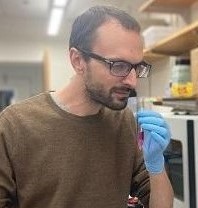
Robert Driver
Matsunami Lab
Association for Chemoreception Sciences XLVI (AChemS XLVI)
Bonita Springs, FL
April 17 – 20, 2024
Abstract
Vertebrates detect odor molecules with olfactory receptors (ORs), a gene family expressed in
the olfactory epithelium. Among species, OR diversity is associated with reliance on smell, with some
mammals exceeding 2,000 OR genes. Birds are the most speciose class of terrestrial vertebrates,
inhabiting nearly all land environments and with diverse social structures and foraging strategies, yet
were long thought to make limited use of olfactory signals. Recent behavioral work in birds has shown
important roles for olfaction in foraging and species recognition, among other behaviors. Contributing
to this surge of interest in avian olfaction, our recent work has shown that birds have hundreds more
OR genes in their genomes than previously realized. We have examined the genomic OR repertoire of
over 150 high quality long-read bird genomes spanning the avian phylogeny, revealing between 7 and
3,800 intact ORs in all species surveyed. To discern the functional roles of ORs, we found that the ORs
are expressed in the bird olfactory epithelium of four species and that bird ORs specifically localize to
the olfactory sensory neurons of the posterior turbinate within the chicken maxilla. To confirm the
ability of bird ORs to detect odors, we expressed chicken ORs in mammalian cell culture, exposed ORs
to multiple odors, and measured OR activation in response to each odor. We found that chicken ORs
respond to several types of pyrazines, a group of chemicals that are found in the scent of green peppers.
Additionally, we show that ORs orthologous between mammals and birds bind the same odors,
illustrating a conservation of OR binding properties through 320 million years of vertebrate evolution.
Together, these results show that bird OR genomic counts are diverse, evolve dynamically, are
expressed in olfactory sensory neurons, and are capable of functionally detecting odors. This work
provides the foundation for future functional characterization of bird ORs across a variety of bird
species.

Alwyn Ecker
Smith Lab
Allied Genetics Conference (TAGC)
Washington, D.C.
March 6 – 10, 2024
Abstract
Investigating Tuberculosis Disease Tolerance versus Susceptibility in a Diverse Murine Model
Mycobacterium tuberculosis (Mtb), the causative agent of tuberculosis (TB) disease, is currently the leading cause of death
by an infectious agent. Clinically, Mtb results in heterogenous outcomes where most individuals can contain or ‘tolerate’ the
infection while others will go on to develop an active infection. Research has traditionally focused on identifying host and
pathogen resistance pathways in the context of active TB infection. However, there is a growing appreciation for the arm of
the host immune defense involved in disease tolerance. Disease tolerance manifests when host resistance mechanisms
weaken, or in cases of chronic infections like TB, the host activates alternative protective mechanisms to minimize collateral damage to its tissues, while minimizing harm to the pathogen. Host and Mtb mechanisms that allow for individuals to ‘tolerate’ infection have been relatively unexplored, in part due to the lack of a murine model that recapitulates Mtb-specific disease tolerance. In published work from our laboratory, we infected over 50 Collaborative Cross mouse strains, and identified specific CC strains that recapitulate distinct TB disease states. One of these strains was CC023/GeniUNC
(CC023). We have identified CC023 as a novel murine model of Mtb-specific disease tolerance. Upon low dose aerosol
infection with ~100 Mtb wildtype H37Rv bacilli, CC023 maintains high bacterial burden as well as elevated levels in proinflammatory cytokines (i.e. TNF-α, IL-17, MIP-1 α). To elucidate host genetic factors that contribute to the disease tolerance phenotype in CC023, we have identified candidate host genes that underlie disease tolerance. Among these genes, a top candidate gene is gasdermin A (Gsdma) on chromosome 11. Gsdma is part of the gasdermin gene family, and they are implicated in pyroptosis. The role of Gsdma has not been elucidated for Mtb infection. We infected Gsdma-/- mice to see if Gsdma-/- would phenocopy CC023’s high bacterial burden and cytokine profiles, underscoring its role in CC023’s disease tolerance phenotype. Our results demonstrate that Gsdma-/- mice have an intermediary Mtb phenotype compared to the canonical C57BL/6J (increased bacterial burden, and unique cytokine profile) but does not phenocopy the high bacterial burden and cytokine profile of CC023. These results suggest that CC023’s disease tolerance is independent of Gsdma, and Gsdma may be additive rather than the driver of the disease tolerance in CC023.

Jun Huang
Heitman Lab
Molecular Mycology: Current Approaches to Fungal Pathogenesis Course
Woods Hole, MA
July 27 - August 12, 2024
Abstract
Loss of RNA interference in Cryptococcus neoformans clinical and environmental isolates: a pathway to hypermutation
Jun Huang1, Shelby J. Priest1, Fred Dietrich1, Paul Magwene2, Vikas Yadav1, Connor Larmore1, Sheng Sun1, and Joseph Heitman1
To survive and proliferate in changing environments, microbes have evolved multiple mechanisms for rapid adaptation. While an increased mutation rate typically has negative consequences in multicellular organisms, hypermutation can be advantageous for microbes subjected to significant selective pressures. Previously, we identified two hypermutator Cryptococcus neoformans clinical isolates, Bt65 and Bt81, that can rapidly overcome antifungal selection by uncontrolled transposition of a specific retrotransposon, Cnl1. These isolates harbor a nonsense mutation in a novel RNAi component, Znf3, and have accumulated a tremendous transposon burden (~150 copies of Cnl1), and loss of RNAi is responsible for hypermutation. To better understand the adaptation mechanisms following RNAi loss in C. neoformans, we developed two bioinformatics pipelines to identify additional isolates with RNAi loss-of-function mutations by screening an extensive Strain Diversity Collection. Remarkably, several loss of RNAi isolates were identified but these isolates do not exhibit a hypermutator phenotype and have not undergone transposon amplification. To test if the identified RNAi loss-of-function mutations could lead to hypermutation, we introduced the mutations into a non-hypermutator strain with a high transposon burden. Indeed, these engineered strains now exhibit a hypermutator phenotype. To further investigate if these RNAi loss isolates can become hypermutators, they were crossed with an isolate containing a high Cnl1 burden. F1 hypermutator progeny were identified with distinct mutation spectra. In addition to the Cnl1 insertion, the transposition of a novel gigantic DNA transposon KDZ1 (~11 kb), widely distributed in natural isolates with varying copy numbers, contributed to the hypermutator phenotype of the progeny. Taken together, our results suggest natural isolates with RNAi defects are not uncommon and many lie on a pathway to hypermutation. Additional passage assays are being conducted to determine the connection between RNAi loss and transposon burden in contributing to the evolution of hypermutator isolates.

Federica Mosti
Silver Lab
Developmental Basis of the Nervous System Diversity: Molecular, Cellular and Organism level (Neural Development - Gordon Research Conference)
Barga, Italy
July 27 - August 2, 2024
Abstract
Multi-modal investigation reveals pathogenic etiology of diverse DDX3X missense mutations.
Authors: Federica Mosti, Mariah L Hoye, Carla Escobar-Tomlienovich, Debra L. Silver
Missense mutations in the RNA-binding protein DDX3X are associated with intellectual disabilities and DDX3X syndrome. While the effect of loss of DDX3X has been characterized during neurodevelopment, how the missense mutations mechanistically perturb cellular function is largely unknown. We utilized lentivirus to deliver DDX3X missense mutations in mouse primary cultures and employ live imaging to investigate cell fate chances. We discovered differential reduction in neurogenesis and increase in apoptotic neurons between clinically severe and clinically milder mutations. This suggests an association between clinical phenotypes and neuroprogenitors’ ability to generate and maintain neurons. Surprisingly, progenitors expressing clinically severe mutations exhibit increased DNA damage and bulk RNA-seq reveals a more extensive upregulation of DNA damage response genes compared to mild mutations. Proteomics analysis highlights protein-protein interactions between DDX3X mutants and proteins involved DNA damage and protein localization. Finally, we analyzed physical properties and protein composition of DDX3X cytoplasmatic stress granules and observed a correlation between higher rate of cells with stress granules and more severe clinical outcome and apoptosis. This study reveals association between DDX3X syndrome missense mutations clinical phenotypes, DNA damage rate and neurogenesis defect.
2019 MGM Distinguished Fellows Travel Awards

Tulika Singh
Permar Lab
7th Pan-American Dengue Research Network Meeting: Lima 2020
Lima, Peru
April 19-23, 2020
Abstract
Isolation of a ZIKV-neutralizing IgM from a pregnant woman in Brazil as a candidate antibody-based prophylaxis during pregnancy
Introduction: Congenital transmission of Zika virus (ZIKV) in ~7-14% of infants born to ZIKV-infected mothers may lead to lifelong morbidity with symptoms like microcephaly, neurodevelopmental defects, visual impairment, and motor dysfunction. Without licensed vaccines, passive administration of immunoglobulin to pregnant women may be a valuable prophylactic option.
Objective: We sought to isolate affinity matured neutralizing antibodies from ZIKV-specific memory B cells in a pregnant Brazilian woman with prolonged viremia.
Methods: PBMCs were collected 30 days after viremia cleared. ZIKV-specific memory B cells (CD14-/CD16-/CD3-/CD19-/IgD-) were sorted using fluorescently-labelled UV-inactivated ZIKV, stimulated with EBV and plated at limiting dilution in presence of CD40L-expressing MS40L cells, ODN2006, IL-21 and CHK2-inhibitor for 14 days. A B cell line was derived from a ZIKV+/IgM+ B cell clone, and purified monoclonal antibody (mAb) was tested for ZIKV and dengue virus (DENV) serotypes 1-4 binding and neutralization.
Results: Subject B1_0037 had high titers of ZIKV and DENV1-4 neutralizing antibody. Six of 14 Ig+ culture supernatants (5 IgG and 1 IgM) confirmed reactivity with ZIKV (OD450>1). From one immortalized ZIKV+/IgM+ B cell line, we isolated mAb DH1017.IgM. DH1017.IgM potently neutralized ZIKV (FRNT50= 6-24 ng/mL), bound to ZIKV (E50= 46 ng/ml), E protein dimer (E80=228 ng/ml) and weakly to E protein monomer (E80=934 ng/ml), but not to E domains I and III. DH1017.IgM did not bind or neutralize DENV1-4.
Conclusions: From a memory B cell, we isolated a ZIKV type-specific and strongly neutralizing mAb DH1017.IgM, which appears to bind to a quaternary structure epitope displayed on the E dimer. Since IgM cannot be transferred across the placenta, this mAb would not facilitate fetal disease by transcytosis of ZIKV, nor increase risk of severe DENV infection for the newborn. These characteristics suggest a role of IgM memory B cells in protection against ZIKV infection and posit DH1017.IgM as a suitable candidate for a prophylactic ZIKV intervention during pregnancy.
___________________________________________

Calla Telzrow
Alspaugh Lab
11th International Conference on Cryptococcus and Cryptococcosis
Kampala, Uganda
June 1-5, 2020
Abstract
Defining arrestin-regulated adaptive cellular responses in fungal virulence
In order to effectively cause disease, pathogens must sense and adapt to dynamic environments. Arrestin proteins are potent regulators of these adaptive cellular responses. Arrestins are a structurally specialized and functionally diverse group of proteins that modulate intracellular responses to extracellular signals. Previous studies on fungal arrestins have demonstrated their roles in classical arrestin functions, such as G protein-coupled receptor desensitization and membrane protein endocytosis, but the mechanisms by which arrestin-regulated processes are involved in fungal virulence remained unexplored. Based on protein structure homology to human arrestins, we identified a family of four putative arrestin proteins – Ali1, Ali2, Ali3, and Ali4 – in the human fungal pathogen Cryptococcus neoformans. The arrestin loss-of-function mutants exhibited varying degrees of sensitivity to cell surface stressors and high temperature. Additionally, macrophage co-culture assays indicated that the arrestin family supported virulence. To probe these shared phenotypes, we have focused initial studies on Ali1. We observed that Ali1 localized to the septum, and that the Ali1 loss-of-function mutant displayed cytokinesis defects. These data implicate Ali1 in the regulation of cytokinesis. Based on preliminary co-immunoprecipitation experiments, Ali1 interacts with multiple proteins involved in cell surface synthesis. Collectively, we hypothesize that Ali1 acts as an adaptor protein for enzymes that synthesize and rebuild the cell membrane and cell wall during cytokinesis. Future studies will focus on mechanisms, such as ubiquitination, by which Ali1 regulates the localization and function of these enzymes throughout the cell cycle. By functionally characterizing each of the C. neoformans four arrestin proteins, this work will enhance the basic biological understanding of arrestin functions, as well as establish the active role of fungal arrestins in virulence.
___________________________________________

Gilberto Padilla Mercado
Rawls Lab
The Allied Genetics Conference (TAGC) 2020
DC Metro Area
April 22-26, 2020
Abstract
DNA methylation plays an important role in maintenance of regional gene expression signatures of the gut
The intestinal tract is organized into distinct regions with specific roles in the digestion and absorption of dietary nutrients. Regional gene expression programs along the anteroposterior axis of the gut play essential roles in the absorption of dietary nutrients. These gene programs are conserved from zebrafish to mice to humans. Some gene expression programs governing responses to environmental stimuli (such as microbes) also impart regional identity in the gut. However, the underlying mechanisms regulating these gene programs are not fully understood. DNA methylation is one epigenetic regulator of gene expression, and recently has been found to play a role in maintaining regional identity in human intestinal organoids. Additionally, it has been shown that defects in DNA methylation maintenance machinery in zebrafish can disrupt barrier function and induce inflammatory programs in the gut. Similar DNA methylation mutants also show an increase of type I interferon responses due to derepression of endogenous retroviral elements. Utilizing a combination of transgenic lines labelling different regions of the gut with fluorescence microscopy, I show that regional identity requires DNA
methylation maintenance in vivo. I also propose a future plan to establish a model in zebrafish which I will use to test my hypothesis that antiviral innate immune pathways play a unique role in maintaining proper regional expression patterns of gene programs important for nutritional and inflammatory processes in the intestinal tract.
___________________________________________

Erika Hughes
Tobin Lab
Keystone Symposia- Tuberculosis: Immunity and Immune Evasion
Santa Fe, NM
Jan 16-20, 2020
Abstract
Single-cell RNA-seq of zebrafish granulomas reveals altered cell composition and inflammatory expression profiles associated with dysregulated eicosanoid signaling
In humans and a zebrafish model of mycobacterial infection, variation at the lta4h locus has been implicated in disease severity and treatment response. The enzyme encoded at this locus, leukotriene A4 hydrolase (LTA4H), acts in the synthesis of a pro-inflammatory signaling eicosanoid, leukotriene B4. In an early zebrafish infection model, loss of LTA4H function leads to hypersusceptibility, excessive mycobacterial growth, and increased disease severity. Here we examine the consequences of genetic dysregulation of eicosanoid synthesis on mature mycobacterial granulomas using single-cell RNA-seq of lta4h granulomas as well as a granuloma explant culture technique. We find that granulomas from an lta4h deficient background show altered morphology with a decreased capacity to contain and restrict mycobacterial growth. Furthermore, scRNA-seq revealed the transcriptional profile of altered granulomas, as well as the dramatic loss of a specific immune cell subset in lta4h deficient granulomas. These findings suggest roles for specific eicosanoid species in controlling granuloma cellular composition, transcriptional profiles, and disease trajectory.
___________________________________________

Kelly Hughes
Klotman Lab
HIV Pathogenesis and Cure Keystone Symposium
Keyston, CO
March 22-27, 2020
Abstract
Proliferation of HIV-1 infected renal epithelial cells following virus acquisition from infected macrophages
HIV-1 can infect and persist in different organs and tissues, resulting in the generation of viral compartments and reservoirs. The persistence of multiple viral reservoirs serves as a significant barrier to HIV-1 cure.
Increasing evidence supports the role of the kidney as a reservoir for HIV-1. Although it is well recognized that HIV-1 infects renal epithelial cells, how the virus enters kidney cells and their fate following infection requires further investigation. We have previously shown that the kidney is a site of HIV-1 infection, and that it represents a separate compartment for HIV-1 replication. We have demonstrated that renal tubule epithelial (RTE) cells acquire HIV-1 through cell-cell contact with infected T cells and that renal cells support the full HIV-1 replication cycle. In addition to CD4+ T cells, macrophages represent the other major target of HIV-1.
Here, using multiparametric histochemistry analysis of kidney biopsies from individuals with HIV-1 associated nephropathy (HIVAN) we show that macrophages are abundantly present in the renal inflammatory infiltrate. Using a co-culture system, we observed contact-dependent HIV-1 transfer from infected macrophages to renal epithelial cells in both primary and immortalized renal cells. Live imaging of HIV-1 infected renal cells revealed four different fates: proliferation consistent with and suggestive of clonal expansion, hypertrophy, latency and cell death. Our study indicates that macrophages may play an important role in the dissemination of HIV-1 in the kidney and that expansion of infected renal cells may contribute to HIV-1 persistence in this anatomical compartment.
___________________________________________
 Holly Haver
Holly Haver
Scaglione Lab
International Dictyostelium Conference
Ann Arbor, MI
August 4-8, 2019
Abstract
SRCP1 utilizes functional amyloid to suppress polyglutamine aggregation.
The polyglutamine (polyQ) diseases are a class of incurable neurodegenerative diseases caused by the
expansion of a polyQ tract in specific proteins, resulting in protein aggregation. One potential therapeutic
approach is the development of strategies to reduce polyQ aggregation. We and others have found that the
model organism Dictyostelium discoideum naturally encodes long polyQ tracts but is resistant to polyQ
aggregation. Work from our laboratory has identified a novel molecular chaperone, serine-rich chaperone protein
1 (SRCP1), that is both necessary for D. discoideum’s resistance to polyQ aggregation and sufficient to impart
resistance to other organisms. The molecular mechanisms SRCP1 utilizes to suppress polyQ aggregation are
currently unknown. Here we show that SRPC1 utilizes a functional amyloid domain to suppress polyQ
aggregation. Using in vitro polyQ aggregation assays we demonstrate that a synthetic peptide of the functional
amyloid domain is sufficient to suppress polyQ aggregation. To further understand structural aspects that
mediate SRCP1 function, we have generated a computational model of SRCP1. Importantly, SRCP1’s Cterminal
domain is predicted to form a β-hairpin structure consistent with it forming functional amyloid.
Interestingly, SRCP1’s serine-rich N-terminus is predicted to interact with SRCP1’s functional amyloid domain.
Because serine-rich regions of proteins can suppress protein aggregation, this led us to hypothesize that
SRCP1’s N-terminal domain may function to suppress amyloid formation by SRCP1’s C-terminal domain.
Consistent with this we find that mutation of serines in SRCP1’s N-terminus results in the formation of SRCP1
aggregates in cells. Together our data are consistent with SRCP1 utilizing functional amyloid to suppress polyQ
aggregation.
___________________________________________
 Matthew Detter
Matthew Detter
Marchuk Lab
Vascular Biology 2019
Monterey, CA
October 27-31, 2019
Abstract
Cell lineage studies of cerebral cavernous malformations(CCMs): elucidating the role of mutant and incorporated endothelial cells in CCM pathogenesis
Objective: Cerebral cavernous malformations (CCMs) are clusters, or caverns, of abnormally dilated and brittle capillaries within the central nervous system. KRITI (CCMI), MGC4607 (CCM2), and PDCDIO (CCM3) have been identified as causative genes in CCM pathogenesis. Our previous work with a CCM3 mouse model discovered that mutant endothelial cells clonally expand during the formation of CCMs. In addition to the clonal expansion of mutant endothelial cells, we also observed a significant population of unlabeled, presumably wildtype, endothelial cells incorporated in the growing malformations. The focus of the current study is to visualize the mutant and incorporated endothelial cells in CCMs and to determine the transcriptional profile of these two different populations of endothelial cells to further understand the pathogenesis of these malformations and potentially identify novel cell signaling pathways for therapeutic intervention.
Methods: We have introduced the nuclear tdTomato / nuclear EGFP (nTnG) transgene into the inducible CCM3 mouse model. The nTnG construct was engineered as a binary cell lineage marker that initially expresses nuclear-localized tdTomato fluorescent protein. Following cre recombinase activity, the cell switches expression of tdTomato to nuclear-localized CFP. We simultaneously induce the loss of the CCM allele and switch from tdTomato to GFP expression within our CCM mouse model. We are labeling CCM-null mutant cells, allowing CCMs to develop overtime, and observing the pattern of fluorescently tagged mutant and incorporated endothelial cells within CCMs. The nTnG binary marker also enables us to separate the mutant endothelial cells, expressing CFP, from the incorporated endothelial cells, still expressing tdTomato, within the CCMs. Utilizing fluorescence-activated cell sorting (FACS), we are able to isolate the mutant and incorporated endothelial cells to perform RNA sequencing to determine gene expression profiles.
Results: Confocal microscopy and 3D reconstructions of 46 individual CCMs suggest that the proportion of mutant to incorporated endothelial cells is independent of CCM size. We analyzed CCMs that ranged from 9 to 228 total endothelial cells and observed a nearly constant ratio of equal numbers of mutant and incorporated endothelial cells. Analysis of the 3D positions of mutant endothelial cells found that the apparent clustering of mutant endothelial cells in the confocal images can be reproduced by random simulations of data permutation. Our current data suggests that CCMs are composed of a significant population of incorporated endothelial cells that become completely mixed with the mutant cells within the growing malformation. This suggests that CCM-null endothelial cells are recruiting or inducing changes within the normal endothelium to drive malformation pathogenesis. To gain mechanistic insights into the cellular signaling events that drive the recruitment of neighboring endothelial cells into the malformation, we have begun to isolate the mutant and incorporated endothelial cells via FACS. We are currently gathering RNA sequence data to determine the unique transcriptomic profiles of the mutant and incorporated endothelial cells in CCMs.
___________________________________________
 Hannah Brown
Hannah Brown
Alspaugh Lab
The International Conference on Cryptococcus and Cryptococcosis
Munyonyo, Uganda
June 1-5, 2020
Abstract
Fungal Membrane Homeostasis is Required for the Response to Alkaline pH
A key virulence attribute of any microbial pathogen is the ability to adapt to the conditions of the infected host. One of these host-associated conditions is neutral/alkaline extracellular pH. Fungal pathogens use the Rim/Pal signal transduction pathway to sense and respond to host pH. Mutants in this pathway are attenuated for survival at alkaline pH and in the infected host. The human fungal pathogen, Cryptococcus neoformans is an important cause of opportunistic infections in immunocompromised patients. This pathogen uses the Rim pathway to regulate cellular changes necessary for growth at alkaline pH. This pathway was first described in the ascomycete phylum. Interestingly, C. neoformans, a basidiomycete, lacks genes encoding many of the components of the Rim pathway, including much of the membrane pH-sensing complex. Additionally, the mechanism by which C. neoformans senses an increase in extracellular pH and how this mechanism might involve the plasma membrane is unknown. This work aims to identify proteins in the C. neoformans Rim pathway that sense changes in pH and investigate how C. neoformans and related basidiomycetes use the organization and composition of the plasma membrane to sense and respond to an elevated extracellular pH. I have completed an insertional mutagenesis screen to identify novel genes required for growth at host pH. These mutants were prioritized based on a sensitivity to alkaline pH that is rescued by active Rim101, suggesting that they are upstream components of the Rim pathway. From this screen I identified a lipid flippase regulatory subunit, Cdc50, as having a role in the initial propagation of the alkaline pH signal through the Rim pathway. I will continue to test if the C. neoformans Cdc50 flippase, and maintenance of plasma membrane asymmetry, are required for Rim pathway activation. I have also completed deep RNA-sequencing analysis to define the transcriptome of the rim101Δ strain to identify targets of the Rim101 transcription factor, the most downstream component of the Rim pathway. The results from this screen reveal a connection between the composition of the plasma membrane and the ability for C. neoformans to respond to external pH changes. Together, these experiments will elucidate the molecular interactions that drive environment-sensing in a large and biologically diverse group of fungi.
___________________________________________
 Jeff Letourneau
Jeff Letourneau
David Lab
Keystone Symposia | Microbiome: Therapeutic Implications
Co. Kerry, Ireland
October 6-10, 2019
Abstract
Gut bacteria degrade dietary fiber and produce short chain fatty acids (SCFAs) beneficial to the host. Variation in community-level response to prebiotic fiber has typically been attributed to differences in community structure. In experiments in our “artificial gut” bioreactor system, we have observed evidence of a lag in the ability of complex communities to degrade a novel prebiotic. We first confirmed that the lack of pH decrease on the first day of inulin dosing was indeed associated with a failure to degrade the prebiotic. On the second and subsequent days of dosing, however, we consistently observed a robust decrease in both pH and concentration of inulin. These differences were not explained by differences in abundance of inulin-degrading taxa, as determined by 16S rRNA sequencing. Conditioned media from inulin-exposed bacteria was insufficient to enable degradation by inulin-naïve bacteria, indicating that extracellular enzymes or outer membrane vesicles were not responsible for the observed lag. These experiments were repeated in vivo in mice, and RNA-Seq was used to identify differential expression patterns associated with the changes in metabolism. These results highlight the importance of studying nutrient sensing as an emergent property of bacterial communities and suggest a need to focus on metabolism in addition to community composition in future microbiome studies.
___________________________________________
 Benjamin Chambers
Benjamin Chambers
Heaton Lab
38th Annual American Society for Virology Meeting
Minneapolis, MN
July 20-24,2019
Abstract
DNA mismatch repair is required for the host innate response and controls
Despite the cytopathic nature of influenza A virus (IAV) replication, we recently reported that
a subset of lung epithelial cells, called club cells, are able to intrinsically clear virus and survive infection.
However, the mechanisms that drive viral clearance and cell survival during a normally lytic infection
remained unclear. We used a loss-of-function screening approach and identified the DNA mismatch
repair (MMR) pathway as essential for club cell survival of IAV infection. And although DNA MMR
activity is greatly reduced during IAV infection of most cell types, it is maintained at normal levels during
infection of club cells. By maintaining DNA MMR activity, club cells are able to repair virally-induced
oxidative DNA damage. This not only allows for cell survival of infection, but also facilitates host gene
transcription, including the expression of antiviral response genes. Engineered viruses capable of
enhanced viral suppression of the DNA MMR pathway prevented club cell survival and increased the
severity of viral disease in vivo. Altogether, these results identify previously unappreciated roles for
DNA MMR as a central modulator of cellular fate and a contributor to the innate antiviral response
during IAV infection, which together, control influenza viral disease severity.
___________________________________________
 Kevin Tsai
Kevin Tsai
Cullen Lab
24th Annual Meeting of the RNA Society
Krakow, Porland
June11-16,2019
Abstract
Regulation of HIV-1 gene expression by post-transcriptional acetylation of cytidine in viral RNA transcripts
As obligate parasites, viruses need to navigate a variety of cellular regulatory systems while
infecting and replicating in the host cell. Post-transcriptional modifications have recently emerged
as an important layer of regulation of viral RNA function. For example, our lab and others have
shown that the RNA modification N6-methyladenosine (m6A) can enhance the replication of
multiple viruses in cis, including Human Immunodeficiency virus 1 (HIV-1), Influenza A virus,
SV40 and Kaposi’s sarcoma-associated herpesvirus (KSHV). Recent reports have revealed the
presence of another RNA modification, N4-acetylcytidine (ac4C), on cellular mRNAs and have
shown that ac4C can enhance mRNA translation. Here, we demonstrate that ac4C is present at
multiple sites on HIV-1 mRNAs and on the viral genomic RNA. A prominent ac4C site was
found on the R region of the long terminal repeats (LTR), which when on the 5’ end contains the
trans-activation response (TAR) hairpin that is essential for viral transcription activation; or on
the 3’ end forms part of the 3’UTR of all viral transcripts, potentially regulating RNA stability or
translation. Furthermore, we have found that varying the expression level of the ac4C
acetyltransferase NAT10 leads to a corresponding effect on viral infection, an effect that is
dependent on the NAT10 RNA binding domain. Our data suggest that HIV-1 has evolved to
incorporate ac4C in essential viral gene coding regions and regulatory RNA structures, and that
NAT10-dependent ac4C addition enhances HIV-1 replication. We will present the latest
developments from this project addressing how ac4C regulates HIV-1 infection, providing us
with new potential points of intervention.
___________________________________________
 Lihua Ye
Lihua Ye
Rawls Lab
FASEB: The Gastrointestinal Tract XVII conference: Intergrated Biology of the GI Super-Organ
Steamboat Springs, Colorado
July28-Aug2,2019
Abstract
Enteroendocrine cells sense gut bacteria and activate a gut-brain pathway
The intestine harbors complex and dynamic microbial communities that contribute significantly to host health and disease. However, mechanisms by which the intestine perceives distinct microbial species and relays that information to the rest of the body remain unresolved. Enteroendocrine cells (EEC) are specialized sensory epithelial cells in the intestine that detect nutrients and other chemicals in the intestinal lumen and respond by releasing hormones via transient increases in intracellular calcium. Recent studies in mice show EEC also synapse directly with vagal neurons and that nutritional stimuli in the intestine can activate this neuroepithelial circuit. Despite these central roles of EEC in intestinal nutrient sensing, it remained unknown if EEC sense bacteria and what the downstream effects may be. To test the impact of bacteria on EEC in vivo, we developed a novel genetic system to record EEC activity in free swimming zebrafish following different bacteria stimulation. In a small screen of zebrafish-associated bacteria, the only strain that significantly elicit EEC activity was the fish pathogen, Edwardsiella tarda (E.tarda). E.tarda stimulation of EEC activity required the Transient Receptor Potential Ankyrin 1b (trpa1b) gene, which was highly expressed in a subset of zebrafish EEC. Trpa1 is a cation channel that can be activated by a range of noxious chemicals including allyl isothiocyanate (AITC). Photochemical activation of Trpa1 in the intestine led to increased peristalsis, and trpa1b mutant zebrafish were unable to clear E.tarda from the intestinal lumen. These data suggest E.tarda or chemical stimulation of Trpa1b promotes clearance of those noxious luminal stimuli via increased intestinal motility. In addition to these intestinal responses, we found that intraluminal delivery of Trpa1 agonist or E.tarda also activated neurons in the vagal ganglia within the central nervous system (CNS). Vagal activation in response to intraluminal Trpa1 agonist delivery was blocked in ret mutant zebrafish that lacks enteric nervous system (ENS), suggesting a requirement for enteric neurons in this signal transduction pathway. Transgene-mediated targeted ablation of EEC revealed that EEC are required for this vagal response to intraluminal Trpa1 agonist and E.tarda stimulation. Collectively, these results indicate that an EEC-ENS-CNS signaling pathway is present in zebrafish, and that EEC are able to activate this pathway in response to distinct bacterial stimuli. This microbe-gut-brain axis could be manipulated to promote specific CNS activities and behaviors, or to treat neurologic disorders which are associated with alterations in the intestinal microbiome.
___________________________________________
 Daniel Snellings
Daniel Snellings
Marchuk Lab
13th HHT International Scientific Conference
Rio Grande, Puerto Rico
June 12-16, 2019
Abstract
HHT Telangiectases Contain Biallelic Mutations in ENG/ACVRL1
Objective: HHT is caused by constitutional heterozygous mutation of ENG, ACVRL1 or SMAD4. Despite the
systemic presence of the mutation, vascular malformations associated with HHT occur focally, rather than
manifesting as a systemic vascular defect. Mouse models of HHT only develop AVMs after an angiogenic
stimulus and only with homozygous loss of the causal genes. Based on these observations we investigated the
hypothesis that one trigger for HHT-associated vascular malformation is a localized somatic mutation resulting
in biallelic loss of endoglin or ALK1.
Methods: We performed targeted deep sequencing on 18 fresh-frozen telangiectases, 2 FFPE telangiectases
and 3 FFPE liver AVMs. The presence of each mutation was confirmed by independent amplification and
resequencing.
Results: Somatic mutations were identified in 9/23 lesions; 5 in ENG and 4 in ACVRL1. Mutations were
identified in 8/18 fresh-frozen telangiectases, 1/2 FFPE telangiectases, and 0/3 FFPE liver AVMs. Somatic
mutations were exclusively present in the same gene as the pathogenic constitutional mutation, with
frequencies ranging from 0.5 to 9%. The mutations consisted of 5 indels causing frameshifts, 3 in-frame
deletions, and 1 variant predicted to impact splicing; all predicted to cause loss-of-function. Currently we have
confirmed that 3/9 constitutional and somatic mutation pairs are biallelic with no evidence that any pairs occur
on the same allele. Additionally, multiple lesions taken from singular patients contain unique somatic
mutations.
Conclusion: These data support the long-standing but unproven hypothesis that biallelic loss of endoglin or
ALK1 is a critical event in the development of an HHT-associated vascular malformation.
___________________________________________
 Hannah Brown
Hannah Brown
Alspaugh Lab
Molecular Mechanisms of Host-Pathogen Interactions and Virulence in Human Fungal Pathogens
La Colle sur Loup, France
May 18-24, 2019
Abstract
Defining pH-Sensing in Fungal Virulence
A key virulence attribute of any microbial pathogen is the ability to adapt to the conditions of the infected host. One of these host-associated conditions is neutral/alkaline extracellular pH. Fungal pathogens use the Rim/Pal signal transduction pathway to sense and respond to host pH. Mutants in this pathway are attenuated for survival at alkaline pH and in the infected host. The human fungal pathogen, Cryptococcus neoformans is an important cause of opportunistic infections in immunocompromised patients. This pathogen uses the Rim pathway to regulate cellular changes necessary for growth at alkaline pH. This pathway was first described in the ascomycete phylum. Interestingly, C. neoformans, a basidiomycete, lacks genes encoding many of the components of the Rim pathway, including much of the membrane pH-sensing complex. Additionally, the mechanism by which C. neoformans senses an increase in extracellular pH and how this mechanism might involve the plasma membrane is unknown. This work aims to identify proteins in the C. neoformans Rim pathway that sense changes in pH and investigate how C. neoformans and related basidiomycetes use the organization and composition of the plasma membrane to sense and respond to an elevated extracellular pH. I have completed an insertional mutagenesis screen to identify novel genes required for growth at host pH. These mutants were prioritized based on a sensitivity to alkaline pH that is rescued by active Rim101, suggesting that they are upstream components of the Rim pathway. From this screen I identified a lipid flippase regulatory subunit, Cdc50, as having a role in the initial propagation of the alkaline pH signal through the Rim pathway. I will continue to test if the C. neoformans Cdc50 flippase, and maintenance of plasma membrane asymmetry, are required for Rim pathway activation. I have also completed deep RNA-sequencing analysis to define the transcriptome of the rim101Δ strain to identify targets of the Rim101 transcription factor, the most downstream component of the Rim pathway. The results from this screen reveal a connection between the composition of the plasma membrane and the ability for C. neoformans to respond to external pH changes. Together, these experiments will elucidate the molecular interactions that drive environment-sensing in a large and biologically diverse group of fungi.
___________________________________________
 Michael Hoy
Michael Hoy
Heitman Lab
FEBS Advanced Lecture Course: Human Fungal Pathogens
La Colle sur Loup, France
May 18-24, 2019
Abstract
Increased fungal specificity of novel FK506 analogs confers both in vitro and in vivo antifungal efficacy
Invasive fungal infections caused by Aspergillus fumigatus, Candida albicans, and Cryptococcus
neoformans total more than 1.6 million cases per year with up to 95% mortality. Although many
antifungal drugs are used clinically, new antifungal drug targets are uncommon. The natural product,
FK506, inhibits calcineurin which is a serine-threonine specific phosphatase and a key virulence factor
in pathogenic fungi. However, FK506 is not used to treat fungal infections due to the
immunosuppressive effect of inhibiting human calcineurin function. In fact, FK506 is commonly used
clinically to immunosuppress patients receiving solid organ transplants. In both fungi and mammals,
FK506 binds to the immunophilin, FKBP12, and then binds calcineurin and inhibits its activity by
blocking binding to substrates. Although mammalian and fungal FKBP12 are highly conserved, we
have identified a key differential residue in the 80s loop proximal to the FK506 binding pocket that can
be exploited to design FK506 analogs with increased fungal specificity.
One FK506 analog, APX879, differs from FK506 by a single chemical substitution. APX879 retains
antifungal activity in vitro, and in vivo reduces fungal burden and extends animal survival in a murine
inhalation model of cryptococcosis. The structure of C. neoformans calcineurin-FK506-FKBP12
suggests that the moiety modified in APX879 will not affect its binding to FKBP12, but instead will
alter how it interacts with calcineurin. Importantly, compared to FK506, APX879 exhibits a marked
decrease in immunosuppressive activity assessed by IL-2 production in primary T cells. Additional
FK506 analogs modified at the same site maintain antifungal activity similar to APX879 and provide a
platform for probing the differences between the fungal and human ternary complexes. By utilizing a
combination of structural biology and medicinal chemistry, calcineurin inhibitors can be generated with
an improved therapeutic window due to decreased action on the host.
___________________________________________
 Nandan Gokhale
Nandan Gokhale
Horner Lab
CSHL RNA Control and Regulation
Cold Spring Harbor, NY
May 29-June 3,2019
Abstract
Altered m6A modification of cellular transcripts influences Flaviviridae infection
The RNA modification N6-methyladenosine (m6A) can post-transcriptionally control
eukaryotic mRNA fate to modulate many biological processes. While we have previously found
that m6A modification of viral RNA genomes regulates infection by RNA viruses in the Flaviviridae
family, the function of m6A modification of cellular mRNA during viral infection is unclear. To
address this, we analyzed m6A across the transcriptome following infection by dengue virus
(DENV), Zika virus (ZIKV), West Nile virus (WNV), and hepatitis C virus (HCV). We found that all
four viruses similarly alter the m6A modification of specific cellular transcripts, without affecting
the overall distribution of m6A across the transcriptome. Importantly, we found that cellular
pathways that are activated by Flaviviridae infection, including innate immune sensing and ER
stress response, contribute to the observed changes in m6A modification. To understand the
function of m6A on specific transcripts during Flaviviridae infection, we focused on two transcripts:
RIOK3, which gains m6A following infection, and CIRBP, which loses m6A. For RIOK3, the
addition of m6A promotes its translation during infection, while for CIRBP, loss of m6A during
infection leads to its alternative splicing. Further, several m6A altered transcripts including RIOK3
and CIRBP encode proteins which influence DENV, ZIKV, and HCV infection. Overall, this work
illuminates that cellular signaling pathways activated during Flaviviridae infection lead to
alterations in m6A modification of host mRNAs to regulate infection.
___________________________________________
 Zachary Holmes
Zachary Holmes
David Lab
Keystone Symposium – Microbiome: Therapeutic Implications
Killarney, Ireland
October 6,2019
Abstract
Butyrate Production from Prebiotics by the Microbiomes of Children with Obesity is Predicted by Individual and Type of Prebiotic
Pediatric obesity remains a public health burden and continues to increase in prevalence. The gut microbiome
plays causal roles in obesity and is a promising therapeutic target. Specifically, the microbial production of the
short-chain fatty acid (SCFA) butyrate from the fermentation of otherwise indigestible dietary carbohydrates
may protect against pediatric obesity and metabolic syndrome. Still, it has not been demonstrated that
therapies involving microbiome-targeting carbohydrates, known as prebiotics, will enhance gut bacterial
butyrate production in children and adolescents with obesity. Here, we use an in vitro system to examine the
SCFA production by fecal microbiota from 17 children with obesity when exposed to five different commercially
available over-the-counter (OTC) prebiotic supplements. We found that the microbiota from 14 of 17 patients
(82%) produced butyrate from at least one OTC prebiotic, but that the supplements varied in butyrogenic
potential. In addition, no one prebiotic supplement increased butyrate production in all of these 14 patients.
This result suggests that multiple prebiotics may be necessary to support butyrate production across
individuals. Significant inter-individual variation also existed in butyrate production across the prebiotics tested,
which 16S rRNA sequencing supported as being associated with differences in host microbiota composition.
Our modeling also suggests that distinct ecological networks may be responsible for butyrate production from
different prebiotic substrates. Together, these findings support the hypothesis that personalized OTC prebiotic
supplementation could be used to augment butyrate levels in children and adolescents with obesity.
___________________________________________
2018 MGM Distinguished Fellows Travel Awards
 Alyson Barnes
Alyson Barnes
Ko Lab
Chlamydia Basic Research Society Meeting
Seattle, WA
March 18-21, 2019
Abstract
Human Genetic Variation Near the TLR1/6/10 Locus Regulates Cytokine Production in Response to chlamydia trachomatis
Chlamydia trachomatis (C. trachomatis) is the most common sexually transmitted disease with more than
1.7 million cases diagnosed in 2017. This is reflective of the fourth consecutive year of a sharp increase in
incidence. Approximately 80% of infections in women are asymptomatic, and if left untreated, C. trachomatis
infection can lead to pelvic inflammatory disease (PID), ectopic pregnancies, and infertility. Importantly, the
variation in interindividual responses is clinically unclear. Identifying how C. trachomatis activates the host
immune system is essential to understanding C. trachomatis pathogenesis. H2P2, a novel discovery platform for
genome wide association studies linking human genetics to host-pathogen interactions, identified a single
nucleotide polymorphism (SNP) uniquely associated with C. trachomatis-induced cytokine production.
Differential expression of inflammatory cytokines has already been correlated with different disease outcome in
the mouse model of C. trachomatis. While the strongest association is with IFNa2 (p=4.6×10-8, surpassing
genome-wide significance), we observed an additional 10 cytokines that showed an association (p<0.01) with
this same SNP. The A-genotype is correlated with higher C. trachomatis-induced cytokine production than the
G-genotype. Interestingly, this SNP is located 500kb away from the TLR1, TLR6, TLR10 region and regulates
the expression of all three toll-like receptors (TLRs), the A-genotype correlating with higher TLR expression.
TLRs are well characterized as crucial receptors for pathogen-associated molecular patterns (PAMPs). This
leads us to believe that higher TLR1, TLR6, and/or TLR10 expression leads to higher C. trachomatis-induced
cytokine production. Consistent with the hypothesis that TLR gene expression is responsible for cytokine
variation, I have shown that C. trachomatis-induced cytokine production in lymphoblastoid cells (LCLs) is 1)
observed with heat-inactivated elementary bodies (EBs) and 2) dependent on MyD88 which is downstream of
both TLR1 and TLR6 signaling. Additionally, further experimentation indicates that TLR1 and TLR6 are
responsible for the cytokine signal variation and the effects are additive, suggesting parallel TLR pathways are
involved. This study also verifies the mechanisms delineating how this SNP regulates the expression of the distal
TLR genes. Preliminary data indicates that the SNP is in linkage disequilibrium with two additional SNPs located
in an enhancer that forms a chromatin loop to directly contact the TLR6/TLR1 promoter. Taken together, these
data verify the genetics between a SNP and gene interaction and begin to establish an in vitro molecular
mechanism by which C. trachomatis activates the host immune system. With future studies correlating human
genetics, C. trachomatis-induced cytokine production, and patient outcomes in a clinical setting, this project
could potentially identify a biomarker of predictive diagnosis and inform future studies of therapeutic
development.
___________________________________________
 Alfred Harding
Alfred Harding
Heaton Lab
Gordon Research Conference Viruses and Cells: Biology of Infection Across Diverse Viral Systems
Renaissance Tuscanny II Ciocco
May 25-31, 2019
Abstract
Genome wide CRISPR cas9 screening identifies a new negative regulator of the type-I IFN response pathway
Influenza virus infects approximately 20% of the global population each year. The first
line of defense for an infected individual is the type-I interferon (IFN) response pathway,
which aids in reducing viral spread and enhancing the adaptive immune response. This
pathway must be both quickly activated and repressed so that an infected individual can
effectively clear the virus without inducing potentially life-threatening inflammation. For
decades researchers have intensely studied the mechanisms by which this antiviral
response is activated, however, relatively little work has been done examining how the
body negatively regulates this pathway. In order to elucidate new potential mechanisms
by which cells control the type-I IFN pathway, we performed a genome-wide CRISPR
Cas9 knockout screen. Our screen identified a gene that has not been previously shown
to regulate this pathway. Characterization of this new regulator demonstrated that it was
both necessary for proper down-regulation of type-I IFN signaling after activation, as
well as sufficient to prevent signaling in the first place. Furthermore, upon both
activating and inactivating this gene with drugs in influenza-infected mice we are able to
both induce and prevent a fatal increase in inflammation as compared to untreated
infected mice. Taken together, the identification of this gene as a negative-regulator of
the type-I IFN response pathway not only serves to enhance our knowledge of its
regulation, but also provides a potential target for immune modulation during infection.
___________________________________________
 Asiya Gusa
Asiya Gusa
Jinks-Robertson Lab
8th FEBS Advanced Lecture Course Human Fungal Pathogens
La Colle sur Loup, France
May 18-24, 2019
Abstract
Temperature stress, transposon-mediated mutagenesis and drug resistance by Cryptococcus neoformans in host model of infection
Cryptococcus neoformans is a human fungal pathogen causing infections primarily in
immunocompromised individuals, such as those with HIV/AIDS or cancer patients undergoing
chemotherapy. Dissemination of Cryptococcus to the brain causes meningoencephalitis, a
condition with a high mortality rate and limited treatment success due to drug resistance.
Previous studies have shown temperature-induced mutagenesis and increased survival of C.
neoformans serotype D (XL280α) in the presence of antifungal drugs in culture. Compared to
growth at 30˚C, there was a 25-fold increase in mutagenesis and drug resistance when
Cryptococcus was grown at 37˚C (human host temperature), largely due to insertions by
transposable elements identified as the DNA transposon T1 and retrotransposon Tcn12. Using a
murine model of infection (37˚C host temperature), this study provides the first evidence that
transposon insertions in the XL280α cryptococcal genome in vivo result in mutations and drug
resistance to 5-fluoroorotic acid and rapamycin/FK506. Cryptococcus mutants resistant to 5-
fluoroorotic acid (insertions in the URA3 or URA5 genes) or rapamycin/FK506 (insertions in
FRR1) were recovered from the organs of mice infected intravenously at 3 and 7 days postinfection.
The number of resistant isolates was compared to the total number of colonies
recovered from the lung, brain, spleen and kidney tissue to determine the mutation frequency.
Significantly, nearly half of the loss of function mutations in the URA3, URA5 and FRR1 genes
were due to transposon insertions. Both the T1 and Tcn12 transposable elements were present at
insertion sites, supporting previous results that showed these elements to be highly mobile at
37˚C in vitro. These results suggest that transposon-mediated mutagenesis at elevated
temperatures may provide a selective advantage for the survival of Cryptococcus in the presence
of antifungal drugs or other hostile host conditions. To explore the effect of temperature on host
survival in a cryptococcal infection, Galleria mellonella larvae were infected with XL280α then
incubated at 30˚C or 37˚C. Killing of the larvae was significantly more rapid at 37˚C, with the
majority of larvae dying between Day 6 and 10 post-infection. Future experiments are planned
to determine if there is a difference in the frequency of transposition in vivo at 30˚C and 37˚C
and whether transposition is important for the survival and pathogenesis of Cryptococcus in the
host.
___________________________________________
 Jake Dockterman
Jake Dockterman
Jörn Coers Lab
Chlamydia Basic Research Society Biennial Conference
Seattle, WA
March 18-21, 2019
Abstract
In mice, cell-autonomous immunity to a variety of intracellular pathogens, such as Chlamydia trachomatis
(Ct), is mediated by the Immunity-Related GTPase (IRG) family of proteins, including the regulatory IRGM
proteins. Briefly, three IRGM proteins differentially regulate the function and subcellular localization of ~18
effector IRGs, which target different subsets of intracellular pathogens or pathogen-containing vacuoles and
mediate their destruction via several mechanisms. Existing single and double IRGM knockout models
display conflicting and confusing phenotypes, implying complex interregulatory relationships between the
three IRGM proteins that have obscured their individual and collective functions. Our lab has recently
developed the first mouse model lacking all three IRGM genes (pan-Irgm-/-), and here we use this model to
examine the collective role of IRGM proteins in cell-autonomous immunity and the inflammatory response to
Ct. We demonstrate defects in IRG localization in vitro, with some IRGs unable to target to Ct but others
unaffected. Interestingly, many downstream immune mechanisms (such as pathogen ubiquitination) remain
intact despite IRG mislocalization. However, pan-Irgm-/- mice fail to resist Ct infection both in vitro and in
vivo, implying unidentified roles for IRGM proteins in immune effector functions downstream of IRG
localization. Furthermore, pan-Irgm-/- mice exhibit drastically increased genital tract inflammation and
pathology after Ct infection in vivo, which could result simply from increased bacterial burden or from a
failure to control the inflammatory response. These findings shed light on the roles of IRGM proteins in
regulating IRG function and other mechanisms of cell-autonomous immunity. They also clarify the
interregulatory relationships among IRGM proteins. Collectively, we have established the pan-Irgm-/- mouse
as an effective model to study the collective role of IRGM proteins in host defense. This model may further
be used in other contexts, including the study of immunity to other pathogens or IRGM-regulated
inflammatory responses.
___________________________________________
 Shelby Priest
Shelby Priest
Heitman Lab
FEBS Advanced Lecture Course on Human Fungal Pathogens
La Colle sur Loup, France
May 18-24, 2019
Abstract
Causes and consequences of hypermutability in Cryptococcus neoformans
To successfully survive and compete within their environmental niches, microorganisms must stochastically acquire mutations or face evolutionary stagnation. Although increased mutation rates are often deleterious in multicellular organisms, hypermutation can be beneficial for microbes in the context of a strong selective pressure. To explore how hypermutation arises in nature and elucidate its consequences, we employed a recently assembled collection of 387 sequenced clinical and environmental isolates of Cryptococcus neoformans, a fungal pathogen responsible for approximately 15% of AIDS-related deaths annually. HIV -positive individuals diagnosed with cryptococcal meningitis face high mortality rates: up to 70% in low income nations and 30% in North America. This high mortality is, in part, attributable to a dearth of antifungal treatment options, so limited because of the conserved homology between many essential fungal and human proteins, and to the high rates of resistance to antifungal drugs. Screening for the ability of each isolate to acquire resistance to otherwise lethal concentrations of diverse antifungal agents identified two robust hypermutators that exhibit increased transposition. Increased transposition of a single element is largely responsible for denovo drug resistance in the two isolates. This element has previously been reported in the sister species, C. deneoformans, but has only been observed to mobilize in RNA interference (RNAi)-defective strains. Therefore, our central hypothesis is that hypermutability caused by frequent transposition in C. neoformans isolates is attributable to the presence of a novel, functional element in the C. neoformans lineage as well as a defect in pathways related to transposon silencing, like RNAi. To determine the genetic and molecular basis of hypermutation due to elevated transposition and to define the impact of this phenotype on the fitness of these strains and their ability to acquire drug resistance in host-relevant conditions, we will 1) utilize quantitative trait loci (QTL) mapping, whole genome sequencing, and genetic recapitulation to elucidate the etiology of hypermutation in these isolates and 2) assay fitness and drug resistance to clinically relevant antifungal drugs through competition assays, Etests, and survival and coninfection assays in two established cryptococcal infection models, Galleria mellonella and mice. Initial QTL analysis of 27 F, segregants from a genetic cross between a hypermutator and the laboratory reference strain, H99, have identified a single significant locus that is associated with inheritance of hypermutation due to increased transposition and includes a nonsense mutation in the first exon of ZNF3, an RNAi component known to be involved in transposon silencing.
___________________________________________
 Calla Telzrow
Calla Telzrow
Alspaugh Lab
FEBS Advanced Lecture Course on Human Fungal Pathogens
La Colle sur Loup, Fance
May 18-24, 2019
Abstract
Defining arrestin-regulated adaptive cellular responses in fungal virulence
In order to effectively cause disease, pathogens must sense and adapt to dynamic environments.
Arrestin proteins are potent regulators of these adaptive cellular responses. Arrestins are a structurally
specialized and functionally diverse group of proteins that modulate intracellular responses to extracellular
signals. Previous studies on fungal arrestins have demonstrated their roles in classical arrestin functions,
such as G protein-coupled receptor desensitization and membrane protein endocytosis, but the mechanisms
by which arrestin-regulated processes are involved in fungal virulence remained unexplored. Based on protein
structure homology to human arrestins, we identified a family of four putative arrestin proteins – Ali1, Ali2,
Ali3, and Ali4 – in the human fungal pathogen Cryptococcus neoformans. The arrestin loss-of-function
mutants exhibited varying degrees of sensitivity to cell surface stressors and high temperature. Additionally,
macrophage co-culture assays indicated that the arrestin family supported virulence. To probe these shared
phenotypes, we have focused initial studies on Ali1. We observed that Ali1 localized to the septum, and that
the Ali1 loss-of-function mutant displayed cytokinesis defects. These data implicate Ali1 in the regulation of
cytokinesis. Based on preliminary co-immunoprecipitation experiments, Ali1 potentially interacted with
multiple proteins involved in cell surface synthesis. Collectively, we hypothesize that Ali1 acts as an adaptor
protein for enzymes that synthesize and rebuild the cell membrane and cell wall during cytokinesis. Future
studies will focus on mechanisms, such as ubiquitination, by which Ali1 regulates the localization and function
of these enzymes throughout the cell cycle. By functionally characterizing each of the C. neoformans four
arrestin proteins, this work will enhance the basic biological understanding of arrestin functions, as well as
establish the active role of fungal arrestins in virulence.
___________________________________________
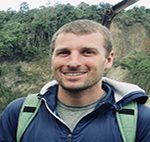 Lee Dolat
Lee Dolat
Valdivia Lab
2019 Biennial Meeting for the Chlamydia Basic Research Society
Seattle, WA
March, 18-21, 2019
Abstract
Chlamydia trachomatis, a Gram-negative obligate intracellular bacterium, is the leading cause of
preventable blindness and most prevalent sexually transmitted bacterial pathogen. To invade
epithelial cells, Chlamydia employs a Type III secretion system (T3SS) to deliver effector proteins
into the host cytosol and reprogram host cell signaling pathways to establish a replication vacuole.
We identified an early effector TepP is tyrosine phosphorylated by host kinases and functions as
a scaffold to modulate host cell signaling. To investigate how TepP reprograms signaling
pathways, we performed a global phosphoproteomic analysis of host cell and bacterial proteins
that are tyrosine phosphorylated in endocervical epithelia infected with wild type or TepP-deficient
Chlamydia. We identified EPS8, a filamentous actin-binding protein that localizes to epithelial tight
junctions and apical microvilli, as the most prominent TepP-dependent target of tyrosine
phosphorylation during infection. TepP and EPS8 colocalize in punctate and tubular-like elements
adjacent to and around nascent inclusions. Live imaging shows that EPS8 is stably associated
with the inclusions while forming dynamic tubules. Furthermore, in polarized epithelia we show
that EPS8 recruitment results in transient cell-cell junction breakdown, loss of transepithelial
electrical resistance and cell dispersion, whereas EPS8 knockout cells fail to disperse. In primary
endometrial organoids, wild type but not TepP-deficient Chlamydia recruit EPS8 and show loss
of apically enriched F-actin, cell-cell junction integrity, and leakage of lumenal fluorescent dextran.
In addition, co-culturing of infected organoids with primary neutrophils, which utilize cell-cell
junctions to transmigrate across the epithelial layer, shows that TepP dampens the recruitment of
neutrophils to infected epithelia. Taken together, these results demonstrate that TepP subverts
EPS8 functions and promotes loss of epithelial cell-cell junctions to possibly increase infection
and suppress the innate immune response.
 Charlie Pyle
Charlie Pyle
Tobin Lab
Keystone Symposia Conference: Tubersulosis, Mechanisms, Pathogensis and Treatment (A3)
Banff, Canada
January 17-21, 2019
___________________________________________
2017 MGM Distinguished Fellows Travel Awards
 Shannon McNulty
Shannon McNulty
Sullivan Lab
American Society for Cell Biology – European Molecular Biology Organization
Philadelphia, PA
December 2-6, 2017
Abstract
Human centromeres produce non-coding alpha satellite RNAs that are chromosomespecific
and required for centromere protein loading
Centromeres serve as the chromatin foundation for the kinetochore and are essential for proper
chromosome segregation. In humans, the centromere on each chromosome is defined by a
homogeneous, repetitive array of alpha satellite DNA. Although alpha satellite DNA was
originally thought to be transcriptionally inert, the presence of histone marks at the centromere
compatible with active transcription and the known role of non-coding centromeric RNA in other
organisms suggest transcription and the resulting transcripts may also be involved in human
centromere function. Recent studies confirmed the presence of alpha satellite transcripts, but the
exact origin of these non-coding RNAs was unclear, as well as their involvement in the
centromere-kinetochore assembly cascade. Using cytological and molecular techniques that
allow alpha satellite arrays on different chromosomes to be molecularly distinguished from each
other, we have demonstrated that each chromosome produces unique non-coding RNAs that
localize in cis to their site of production. Alpha satellite RNAs bind at least two key centromere
proteins: CENP-A, the centromere-specific histone variant, and CENP-C, a component of the
constitutive centromere-associated network of proteins that bridge the centromere and the
kinetochore. Targeted depletion of alpha satellite RNAs from a single chromosome leads to 30%
loss of CENP-A due, at least in part, to deficient loading of new CENP-A-containing
nucleosomes. CENP-C levels are also reduced by nearly half at the targeted centromere.
Importantly, loss of alpha satellite RNA from a single chromosome does not affect the
centromeric RNA or protein levels at any other centromere in the cell, highlighting the cisregulatory
nature of these non-coding RNAs, but it does lead to cell cycle arrest prior to mitosis.
Collectively, these findings implicate non-coding alpha satellite RNA as an essential player in
centromere maintenance and underscore the ability of a single defective centromere to alter cell
cycle progression.
___________________________________________
 Jeff Bryant
Jeff Bryant
Gromeier Lab
EMBO Conference – Proteing Synthesis and Translational Control
Heidelberg, Germany
September 6-9th, 2017
Abstract
Translational Regulation of Hypoxia by DAP5 through PHD2
Hypoxia is a common hallmark of solid tumors. As tumors grow abnormal blood vessel development induces a hypoxic environment within the tumor. Cancer cells undergo a number of genetic changes that allow them to survive these hypoxic conditions. The cellular response to low oxygen environments is regulated through the hypoxia induced transcription factor 1α (HIF-1α). HIF-1α is a transcription factor with activity on more than 60 target genes and its translation is induced by growth factor signaling. Under normoxic condition HIF-1α is rapidly hydroxylated by prolyl hydroxylase-domain protein 2 (PHD2), ubiquininated, and degraded with PHD2. In many human cancers HIF-1α is overexpressed to promote survival in the hypoxic tumor environment. Death associated protein 5 (DAP5) is a homolog of the eIF4F eukaryotic initiation complex scaffolding protein eIF4GI. DAP5 is an important regulator of both global and template specific translation with particular activity during times of cellular stress. Unlike eIF4GI, DAP5 is able to bind to eIF2β, a subunit of the eIF2 complex which delivers methionyl-tRNA to the 40S ribosomal subunit to initiate translation. DAP5:eIF2β binding is regulated through growth factor signaling. We have identified a novel relationship between the translation initiation factor DAP5 and HIF-1α expression. This relationship is determined to regulate HIF-1α through DAP5 directed translation of the hydroxylase PHD2 in a DAP5:eIF2β dependent manner. DAP5 regulation of PHD2 also promotes cell survival during hypoxia. Future work will determine if regulation of PHD2 translation by DAP5 is due to hypoxia induced DAP5:eIF2β binding.
___________________________________________
 Hilary Renshaw
Hilary Renshaw
Steinbach Lab
FASEB: Molecular Pathogenesis: Mechanisms of Infectious Disease
Snowmass, CO
July 9-14, 2017
Abstract
Tail Domain of the Aspergillus fumigatus Class V Myosin Orchestrates Septal Localization and Hyphal Growth
Background/Objective: Myosins are motor proteins classified based on their domain architecture. Class V myosins are critical for the secretory pathway, polarized growth, and cytokinesis in fungi. The globular tail domains of class V myosins in Saccharomyces cerevisiae and Schizosaccharomyces pombe, have been shown to be important for cargo binding and actin cable organization. Additionally, phosphorylation plays a role in class V myosin cargo choice in vertebrates. Our previous studies on the class V myosin, MyoE, in the fungal pathogen Aspergillus fumigatus confirmed its requirement for normal morphology and virulence. However, the domains and molecular mechanisms governing MyoE’s function remain unknown, thus we sought to determine what the molecular requirements are for MyoE function. Based on previous literature, we explored the role of the MyoE tail domain in growth as well as phosphorylation as a potential regulation mechanism of this protein.
Methods: A series of MyoE tail truncation mutants was generated (MyoE-Δ1084, MyoE-Δ1160, MyoE-Δ1249, MyoE-Δ1389) and were assessed for radial growth, conidiation, septation frequency, and MyoE localization. To determine the phosphorylation status of MyoE under basal condition, the MyoE-GFP protein was purified using GFP-Trap™ affinity purification and analyzed using LC-MS/MS to identify phosphorylation sites. In order to understand the role of these sites in MyoE function, serine or threonine residues were substituted for alanine to mimic a nonphosphorylatable state of the protein and radial growth and MyoE localization was assessed. To identify possible regulators of phosphorylation, the MyoE-GFP protein was purified as described previously from a strain lacking the catalytic subunit of the serine/threonine phosphatase, calcineurin, and were analyzed by LC-MS/MS. One additional residue in the tail domain was phosphorylated in the absence of calcineurin. Requirements for this residue were assessed by substituting a serine/threonine for glutamate that mimics a constitutively phosphorylated state and assessing phenotypes.
Results: Using a series of tail truncation mutants, we demonstrate that the MyoE tail is required for radial growth, conidiation, septation frequency, and MyoE localization at the septa and hyphal tip. Furthermore, MyoE is phosphorylated at eight residues in vivo; however, alanine substitution mutants revealed that no single phosphorylated residue was critical for radial growth, conidiation, septation, or localization. Importantly, in the absence of the phosphatase calcineurin, an additional residue was phosphorylated in its tail domain. Mutation of this tail residue led to mislocalization of MyoE from the septa, indicating the importance of dephosphorylation of this particular residue for septal localization.
Conclusion: We demonstrate the importance of the tail domain and proper posttranslation regulation for function of MyoE. Given that the tail domain binds cargo, our future studies aim to gain insight into what types of cargo MyoE may be carrying using proteomic analysis, and how dysregulation of this cargo binding affects growth and pathogenesis.
___________________________________________
 Albert Zhang
Albert Zhang
Yan Lab
21st International C. elegans Meeting
University of California, Los Angeles
June 21-25th, 2017
Abstract
The spatial and temporal regulation of gliogenesis in C. elegans by lin-32
Glia play an important role in most aspects of neural biology, and regulating the number of these cells is important for the proper functioning of the nervous system. During development, gliogenesis is a controlled process that involves many different genes functioning in different cells and at different time points, many of which are not yet know. The purpose of our study is to the molecular mechanisms behind gliogenesis, and we have found that a homolog of the human proneural gene Atoh1, lin-32, is involved in regulating the number of glia in C. elegans. Through genetic analyses, time lapse imaging, and screens, we have found that the transcription factor has a gliogenesis suppressing role that is independent of its proneural function during early embryogenesis. Furthermore, we have identified other proneural transcription factors including cnd-1 and ngn-1 that also appear to negatively regulate glial number. This finding is in line with previous studies showing the mouse ngn-1 homolog promotes a neural fate while independently represses the pathway controlling astrogliogenesis in the developing mouse cortex. The processes regulating gliogenesis and neurogenesis are thus likely to be conserved from invertebrates to vertebrates, and this study suggests that lin-32/Atoh1 may have a conserved and previously unknown function in regulating gliogenesis as well.
___________________________________________
 Shannon Esher
Shannon Esher
Alspaugh Lab
10th International Conference on Cryptococcus and Cryptococcosis
March 26-30th, 2017
Foz do Iguaçu, Brazil
Abstract
Characterizing novel regulators of the Cryptococcus neoformans cell wall and their implications for immune recognition
Cryptococcus neoformans dramatically alters its cell wall, both in size and composition, upon entering the host. Through a genetic screen for mutants with changes in their cell wall, we identified a novel protein with no identifiable domains, which controls cell wall organization and immune evasion. We have named this protein Mar1 for macrophage activating regulator of cell wall 1. We have created an independent loss-of-function mutant and through phenotypic studies have demonstrated that mar1∆ has an aberrant cell wall, resulting in a defect in capsule attachment and attenuated virulence. The mar1∆ mutant displays increased staining for exposed cell wall chitin and chitosan when the cells are grown in host-like tissue culture conditions. Furthermore, by real-time PCR we have shown that several cell wall biosynthesis genes are differentially expressed in the mar1∆ background in these conditions. We have also observed that the PKC1/cell wall integrity pathway is hyper-activated in the mar1∆ background; however through genetic epistasis analysis we have shown that Mar1 is likely not directly regulating the pathway upstream. To determine how the aberrant mar1∆ cell wall is affecting the host-pathogen interaction, we have observed that this strain induces increased macrophage activation as measured by the production of the pro-inflammatory cytokine TNF-a. We have demonstrated that both live and heat killed cells incubated in tissue culture conditions induce this activation, as well as purified cell wall material. In order to elucidate the innate immune receptors responsible for recognizing mar1∆, we have demonstrated that both Card9 and MyD88, the adaptor proteins for many of the C-type lectin and toll-like receptor families respectively, are required. Ongoing work aims to further define the innate immune response to the mar1∆ mutant cell wall, as well as to identify the mechanism of Mar1 cell wall regulation.
___________________________________________
2016 MGM Distinguished Fellows Travel Awards
 Dia Beachboard, PhD
Dia Beachboard, PhD
Horner Lab
FASEB: GTPases in Trafficking, Autophagy and Disease Conference
September 18-23, 2016
West Palm Beach, FL
Abstract
Identification of RAB1B as a positive regulator of antiviral innate immunity
The antiviral innate immune response is activated when pattern recognition receptors, such as RIG-I, sense viral RNA. RIG-I signals through the adaptor protein, MAVS, to induce type I interferons (IFN). MAVS signaling is organized at the interface of mitochondria, peroxisomes, and the mitochondrial-associated ER membranes (MAM). To identify regulators of MAVS function at the MAM, we performed proteomics analysis of the MAM subcellular fraction during the antiviral response. We identified RAB1B, a GTPase required for ER-Golgi anterograde vesicle trafficking, as relocalized to the MAM during innate immune activation. We have found that RAB1B interacts with MAVS, suggesting that it regulates antiviral signaling. To test this, we generated RAB1B knockout cells (KO) using CRISPR/Cas9 genome editing and found that loss of RAB1B results in decreased signaling to IFN-β driven by Sendai virus (SenV), a potent inducer of RIG-I signaling. Conversely, overexpression of RAB1B enhances SenV-induced signaling to IFN-β and mediates restriction of RNA virus infection. Importantly, RAB1B is also required for IRF-3 phosphorylation during RIG-I activation. Mutations within the RAB1B GTPase domain that result in either enhanced or decreased GTPase activity prevent induction of SenV-signaling to IFN-β, mimicking loss of RAB1B. We demonstrate that RAB1B is acting at the level of IKKε to promote signaling to IFN-β. In addition to mediating IFN-induction through IRF3 and NF-kB, IKKε also mediates the IFN-response through activation of STAT1 and induction of a subset of interferon-stimulated genes (ISGs) that are IKKε-dependent. To test whether RAB1B regulates the IFN response, we stimulated RAB1B KO cells with type I IFN and found that they have decreased induction of IKKε-dependent ISGs. These results define RAB1B as a novel positive regulator of the antiviral innate immune response that may coordinate the activation of multiple antiviral pathways to restrict viral replication.
___________________________________________
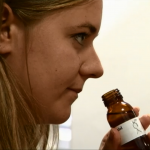 Claire de March, PhD
Claire de March, PhD
Matsunami Lab
17th International Ssymposium on Olfaction and Taste
June 5-9, 2016
Yokohama, Japan
Abstract
Molecular Dynamics simulations reveal the ligand-dependent activation of hOR7D4
The complexity of the odor chemical space and the large number of odorant receptors (ORs) associated to their combinatorial activation make understanding odor coding an enormous challenge. More specifically, being able to predict the behavior of an OR in front of an agonist, an antagonist or a non-agonist remains to be done.[1]
Using a joint approach combining molecular modeling and experimental data on several ORs[2], we have built a model that can capture the active or inactive state of these proteins when bound to ligands with different potencies.[3]
The methodology is illustrated on a challenging case. By the aim of computational tools combined with site directed mutagenesis, we predict the activation of human OR7D4 by its strong agonists, androstenone and androstadienone, and its inactivated form by a non-agonist the (Z)-2-decenal.[4] These models allow us to investigate the activation mechanism of other mammalian olfactory receptors from the binding cavity to the G protein binding site, revealing the network of conserved amino acids involved in ORs activation.
Such powerful approaches will help unravel odor-coding in the nervous system and facilitate the understanding of general rules of neuronal activation induced by an odor.
___________________________________________
 Max Villa, PhD
Max Villa, PhD
David Lab
Diversity Course
July 1, 2016 – August 17, 2016
Woods Hole, MA
Abstract:
My research goal involves the development and application of new tools to understand large and diverse microbial communities. I am designing assays for high throughput co-culture experiments in droplets, allowing for the identification of new inhibitory and/or growth promoting interactions between microbes. Millions of droplet co-cultures can be generated in only a few minutes using a microfluidic droplet generator, and when combined with flow cytometry techniques, thousands of bacterial co-cultures can be screened within seconds. Having begun my scientific training as an engineer, this course bolstered my microbiology training and has greatly enhanced my current research. The Microbial Diversity course at the Marine Biological Laboratory at Woods Hole has helped me to develop new technology for understanding microbial interactions, developed my expertise in the field of microbiology, and facilitated new scientific connections.
___________________________________________
 Sriram Vijayraghavan, PhD
Sriram Vijayraghavan, PhD
McCusker Lab
The Allied Genetics Conference (TAGC 2016)
July 13-17, 2016
Orlando, Florida
Abstract:
Investigating mitochondrial and viral genome contributions to phenotype in Saccharomyces cerevisiae
Determining how genotype translates to phenotype is a complex issue. While rapid progress has been made in linking nuclear genome variations to population traits, much less is known about whether and how extra-chromosomal elements shape phenotypic changes. Using the yeast Saccharomyces cerevisiae as our model, we analyzed the phenotypic contributions from two classes of non-chromosomal elements— mitochondrial DNA and endogenous double-stranded RNA viruses. S. cerevisiae shares highly conserved cellular processes with humans, is ideally suited for Mendelian as well as non-Mendelian genetics, and is markedly similar to clinically relevant pathogenic fungi, making it ideal for our studies.
Through a comprehensive sequence analysis of mitochondrial DNA from 100 geographically diverse strains of S. cerevisiae, we firstly identified a wide range of mitochondrial DNA-associated variations including copy number changes, single nucleotide polymorphisms, indels, and presence/absence of introns within select mitochondrial genes. Subsequently, we created a series of iso(genic)-nuclear diploid strains, each carrying a single, unique mitochondrial genotype, and tested these under diverse environmental conditions to systematically assess the contribution of individual mitochondrial genomes to phenotype. Our results indicate that mitochondrial variations significantly influence phenotypic outcome.
Additionally, we genotyped our 100-genome collection for the presence and absence of several naturally occurring viral dsRNA elements and found that up to a third of the population harbors the well-characterized dsRNA virus L-A. We observed pronounced L-A dependent phenotypic effects in our analysis of isogenic +/- L-A strain pairs. Interestingly, both mitochondrial and L-A genotypes were found to significantly influence several phenotypes, further underscoring the contributions of non-chromosomal genetic determinants to quantitative trait variations.
Our studies highlight the complexity of gene-environment interactions that ultimately determine fitness and survival. Future work would be aimed at identification of the precise genetic loci to understand the mechanistic basis of such phenotypic changes.
2015 MGM Distinguished Fellows Travel Awards
 Kristy Bialas
Kristy Bialas
Permar Lab
5th International Congenital CMV Conference
April 20-24, 2015
Brisbane, Australia
To present poster and talk
Abstract:
Maternal CD4+ T cell depletion enhances congenital rhesus CMV disease
Elucidation of the maternal immune correlates of protection against congenital cytomegalovirus (CMV) is necessary to inform future vaccine design. Here we demonstrate a critical role of maternal CD4+ T cells in protection of the fetus against congenital CMV disease in a novel rhesus macaque model of transplacental rhesus CMV (rhCMV) transmission. In this model, intravenous rhCMV inoculation of immunocompetent, rhCMV-seronegative pregnant females during the early second trimester induced asymptomatic congenital infection, as determined by detection of viral DNA in amniotic fluid and infant saliva, in two of three live-born infants. In contrast, fetal loss (3 of 4) and symptomatic disease in the remaining live-born infant occurred when CD4+ T cell depleted, rhCMV-seronegative pregnant females were inoculated with rhCMV at the same gestational time-point, whereas CD4+ T cell depletion of pregnant females with preexisting rhCMV immunity did not result in virus detection in amniotic fluid or fetal loss. Analysis of the maternal immune responses following primary CMV infection revealed both a delay in autologous neutralizing antibody titers and dampened virus-specific CD8+ T cell responses in CD4+ T cell depleted monkeys compared to immunocompetent monkeys, implicating CD4+ T cell help as a determinant of fetal outcome following acute maternal rhCMV infection.
___________________________________________
 Barbara Sixt
Barbara Sixt
Valdivia Lab
Seventh Biennial Meeting of the Chlamydia Basic Research Society (CBRS 2015)
March 29-April 1, 2015
New Orleans, LA
To present poster and talk
A genetic screen identifies the inclusion membrane protein CioN as a suppressor of host cell death during Chlamydia trachomatis infection
Barbara S. Sixt1,2, Robert J. Bastidas1, Guido Kroemer2, Raphael H. Valdivia1
1 Department of Molecular Genetics and Microbiology, Duke University, Durham, USA
2 Centre de Recherche des Cordeliers, INSERM U1138, Paris, France
Chlamydia trachomatis modulates the programmed cell death machinery of its host cell, presumably to enhance bacterial replication and promote pathogenesis. The identity and function(s) of bacterial anti-death factors are unknown. Our study aimed to exploit recently developed tools for genetic manipulation of chlamydiae to obtain and characterize strains with defects in the control of host cell death. In a screen of a library of mutagenized C. trachomatis L2 we identified a strain that induces elevated levels of cell death. We used genetic techniques and cell culture models to identify the causative mutation and to characterize the protein’s role in cell death and its significance for bacterial replication. Our investigations revealed that cell death induction by this mutant: (1) was dependent on live replicating bacteria, (2) was initiated during mid-stage of infection, (3) could be observed in various cell lines, (4) adversely affected establishment of inclusions, and (5) was predominately of a necrotic nature. Through the use of recombinant analysis, plasmid-based complementation, and directed gene disruption the phenotype could be linked to the loss of an inclusion membrane protein we term CioN (Chlamydial Inhibitor of Necrosis). Our study identified CioN as a novel anti-death virulence factor. The discovery of mutants with defects in host cell death control will help to clarify the role of this virulence trait in Chlamydia pathogenesis.
___________________________________________
 Bryan Hart
Bryan Hart
Lee Lab
2015 World Health Organization Meeting on Buruli ulcer
March 23-25, 2015
Geneva, Switzerland
To present poster and talk
Recombinant BCG Expressing Mycobacterium ulcerans Ag85A imparts enhanced protection against experimental Buruli ulcer
Bryan E. Hart and Sunhee Lee
Human Vaccine Institute and Department of Medicine, Duke University Medical Center, Durham, North Carolina 27710, USA
Abstract
Buruli ulcer, an emerging tropical disease caused by Mycobacterium ulcerans (MU), is characterized by disfiguring skin necrosis and high morbidity. Due to significant reduction in quality of life for those afflicted with extensive tissue scarring, and to the fact that a disproportionately high percentage of those affected are children, a Buruli ulcer vaccine would be greatly beneficial to the worldwide community. Previous studies have shown that mice inoculated with either Mycobacterium bovis bacille Calmette–Guérin (BCG) or a DNA vaccine encoding the M. ulcerans mycolyl transferase, Ag85A (MU-Ag85A), are temporarily protected against footpad swelling caused by intradermal challenge with MU. Building upon this principle, we have generated quality controlled, live-recombinant strains of BCG Danish and M. smegmatis which heterologously express the immunodominant Ag85A from M. ulcerans. Recombinant BCG expressing MU-Ag85A priming followed by a boost with M. smegmatis expressing MU-Ag85A is capable of inducing proliferation of murine antigen-specific CD4+ T cells as well as eliciting functional IFNγ-producing splenocytes which recognize MU-Ag85A peptide and heat killed M. ulcerans better than a BCG prime-boost vaccination. In addition, mice vaccinated with a single dose of BCG MU-Ag85A or a prime-boost using both recombinant mycobacteria displayed significantly enhanced survival, were protected against MU-pathology, and had reduced footpad bacterial loads compared to a BCG prime or prime-boost. To our knowledge, this is the first vaccine which demonstrates superior protection against the mouse model of Buruli ulcer compared to BCG vaccination. These results suggest that use of recombinant BCG as a vehicle to express MU antigens is a novel Buruli ulcer vaccine strategy and warrants further studies to isolate MU-specific immunodominant antigens for improvement of vaccine efficacy.
___________________________________________
2014 MGM Distinguished Fellows Travel Awards
 Liuyang Wang
Liuyang Wang
Ko Lab
2014 Annual Meeting of the American Society of Human Genetics
October 18-22, 2014
San Diego, CA
To present poster and talk
Abstract:
Cross-Phenotype Analysis of GWAS (CPAG): A powerful tool for detecting shared genetic architecture among human traits and underlying shared pathways
Recent large-scale meta-analyses of GWAS have demonstrated that cross-phenotypic associations and pleiotropy are abundant among GWAS hits for various diseases and traits. However, the degree of disease similarity as well as the underlying genetic basis driving such connections remains poorly understood. By integrating GWAS results, we developed a novel approach to estimate the degree of disease similarity, identify informative disease clusters, and highlight the potential underpinning pathways. A probability-based method was used to estimate similarity of traits by correcting unobserved shared genetic components and is therefore less sensitive to small and/or uneven shared similarities. Comparing nearly a dozen similarity methods, we determined which was most optimal and robust. Unlike previous methods such as polygenic score, linear mixed-effect model and network model, our approach is based on analyses of summary statistics without requiring more genotype/phenotype data. Using data from the NHGRI GWAS Catalog, we constructed human disease trees with more than 600 traits by using similarity matrices based on either SNPs, SNPs corrected for linkage disequilibrium, and implicated genes among pairwise diseases. For pairwise comparisons that showed significant similarity, we implemented gene set enrichment analysis to identify possible associated pathways. Our method categorized related diseases into disease clusters well consistent with pre-defined groups but also revealed novel and unexpected disease connections. We validated the cross-phenotype analysis of GWAS (CPAG) method computationally using two different approaches by comparing the CPAG generated categorization to pre-defined categories. All of this functionality for disease similarity, visualizing clustering, and pathway analysis has been implemented into a flexible stand-alone software program, named CPAG. CPAG also accepts user-defined datasets to predict potential disease connections and shared pathways. Our approach will become increasingly powerful with the ever-expanding identification of novel causal genetic variation attributed to different traits, and lead to further understanding of the genetic architecture of complex traits and additional insights into the pathophysiology of diseases. Indeed, we are currently experimentally testing novel human trait connections discovered from our analysis using zebrafish.
___________________________________________
 John McMahon
John McMahon
Silver Lab
2014 Gordon Conference in Neural Development
August 10-15, 2014
Newport, RI
To present poster and talk
Abstract:
Tight regulation of proliferation and differentiation by neuronal progenitors during embryonic neurogenesis is essential for proper formation and function of the cerebral cortex. Early in embryonic neurogenesis neural stem cells (NSCs) divide symmetrically producing two NSCs. As neurogenesis progresses NSCs undergo more asymmetric divisions, producing a NSC and either a neuron or an intermediate neuronal progenitor (INP). Disruption of NSC divisions underlies microcephaly and an array of neurodevelopmental disorders. It has recently been shown that mutations in components of the mRNA binding exon junction complex (EJC) cause disorders associated with neurodevelopmental phenotypes in humans, the mechanism of which remain enigmatic. Previous studies from our group have shown germline haploinsufficiency of the EJC component Magoh (MagohMos2/+)causes microcephaly with precocious neuron production, loss of intermediate neural progenitors (INPs) and induction of apoptosis in mice, yet the cell type specific contributions to these phenotypes remain unknown. We therefore developed a conditional mouse harboring a null allele of Magoh to dissect the role of the EJC in neurogenesis. We find NSC specific Magoh depletion recapitulates neurogenic deficits in a dose dependent fashion, revealing a cell-autonomous requirement of Magoh in NSCs. In contrast neuron-specific Magoh mutant mice showed no evidence of neuronal apoptosis. This indicates neuronal apoptosis in this mutant is likely due to mitotic defects of progenitors rather than a post-mitotic requirement for Magoh. RNAseq and immunostaining reveal a striking activation of the p53 pathway occurs following Magoh depletion. Preliminary data demonstrates that p53 ablation protects against microcephaly induced by Magoh insufficiency. Thus, impairment of EJC function disrupts embryonic neural development, in part through aberrant activation of p53.
___________________________________________
 Silvia Calo Varela
Silvia Calo Varela
Heitman Lab
12th European Conference on Fungal Genetics (ECFG12)
March 23-27, 2014
Seville, Spain
To present poster and talk
Abstract:
RNAi-dependent epimutations evoke antifungal drug resistance in the zygomycete fungal pathogen Mucor
Microorganisms evolve via a panoply of mechanisms spanning aneuploidy, sexual/parasexual reproduction, mutators, Hsp90, and even prions. The pathogenic fungus Mucor circinelloides grows as a hyphae aerobically, but as a yeast in anaerobic conditions or in the presence of the immunosuppressive drug FK506. The antifungal activity of FK506 is exerted in complex with FKBP12, a protein folding enzyme conserved throughout eukaryotes. The FKBP12- FK506 complex inhibits the protein phosphatase calcineurin and thereby blocks hyphal growth of M. circinelloides. Continued exposure to FK506 yields resistant isolates, which exhibit hyphal growth emerging from the yeast colony. Some isolates harbor a variety of Mendelian mutations in the fkbA gene that encodes FKBP12 or the calcineurin genes, conferring stable drug resistance. However, other isolates harbor no mutations in the target genes. These unusual epimutant isolates also revert frequently within several generations of vegetative growth in drug-free media and are restored to wild-type (yeast growth in the presence of FK506). Northern and Western analyses revealed a loss of fkbA mRNA and FKBP12 protein in the epimutants. High-throughput sequencing and Northern blot also detected sRNA generated from fkbA in the epimutant strains, revealing a new role for RNAi in the development of transient, reversible resistance to an antifungal drug treatment. RNAi activation involves generation of a double-stranded RNA trigger intermediate using the fkbA mature mRNA as template. Our results reveal a novel epigenetic RNAi-based epimutation mechanism controlling phenotypic plasticity in fungi.
___________________________________________
 Rebecca Beerman
Rebecca Beerman
Tobin Lab
Southeastern Mycobacteria Meeting
January 24-26, 2014
Birmingham, AL
To present poster and talk
Abstract:
Visualization and manipulation of calcium dynamics in inflammation and infection
Lorem ipsum dolor sit amet, consectetur adipisicing elit, sed do eiusmod tempor incididunt ut labore et dolore magna aliqua. Ut enim ad minim veniam, quis nostrud exercitation ullamco laboris nisi ut aliquip ex ea commodo consequat. Duis aute irure dolor in reprehenderit in voluptate velit esse cillum dolore eu fugiat nulla pariatur. Excepteur sint occaecat cupidatat non proident, sunt in culpa qui officia deserunt mollit anim id est laborum. Lorem ipsum dolor sit amet, consectetur adipisicing elit, sed do eiusmod tempor incididunt ut labore et dolore magna aliqua. Ut enim ad minim veniam, quis nostrud exercitation ullamco laboris nisi ut aliquip ex ea commodo consequat. Duis aute irure dolor in reprehenderit in voluptate velit esse cillum dolore eu fugiat nulla pariatur. Excepteur sint occaecat cupidatat non proident, sunt in culpa qui officia deserunt mollit anim id est laborum.
___________________________________________
2013 MGM Distinguished Fellows Travel Awards
 Robert Bastidas
Robert Bastidas
Valdivia Lab
Cold Spring Harbor Laboratory Microbial Pathogenesis and Host Response
September 17 – 21, 2013
Cold Spring Harbor, NY
To present poster and talk
Abstract:
Genome wide discovery of virulence factors in a “genetically intractable” pathogen
Recent advances in DNA sequencing technologies have made it possible to identify both naturally and experimentally induced genetic variation. In this manner, we can introduce random single nucleotide variation into genomes by chemical mutagenesis, track these gene lesions by whole genome sequencing, and begin to globally address the role of individual genes in microbial cellular processes without the need for molecular genetic tools. In this study, we describe a genetic and computational approach for genome-wide mapping of mutations in a complex library of mutants based on NextGen DNA sequencing technologies. This method was applied to a library of ~1,000 chemically mutagenized Chlamydia trachomatis, an obligate intracellular pathogen of medical importance. We defined the cohort of genes that tolerate loss-of-function mutations and are therefore liable to be dispensable for C. trachomatis growth in cell culture. This sequencing effort provided the basis for the assembly of an ordered library of sequenced Chlamydia strains harboring mutations in non-essential genes, and a platform for the genetic dissection of virulence factors. We validated the utility of this resource by conducting reverse genetic approaches to characterize the host targets of a C. trachomatis effector that is translocated to the host nucleus, the contribution of central metabolism to survival within host cells, and mechanisms used by C. trachomatis to establish a replicative niche inside the host. The application of next generation DNA sequencing technologies, coupled with traditional mutagenesis methods and new bioinformatics tools, should expedite discoveries in pathogens such as Chlamydia and emerging infectious agents that currently intractable to classical molecular genetic manipulation.
___________________________________________
 Stefan Oehlers
Stefan Oehlers
Tobin Lab
Cold Spring Harbor Laboratory Microbial Pathogenesis and Host Response
September 17 – 21, 2013
Cold Spring Harbor, NY
To present poster and talk
Abstract:
Interception of host angiogenic signalling limits mycobacterial growth
Pathogenic mycobacteria induce the formation of complex cellular aggregates called granulomas that are the hallmark of tuberculosis. Here we examine the development and consequences of vascularization of the tuberculous granuloma in the zebrafish–Mycobacterium marinuminfection model, which is characterized by organized granulomas with necrotic cores that bear striking resemblance to those of human tuberculosis. Using intravital microscopy in the transparent larval zebrafish, we show that granuloma formation is intimately associated with angiogenesis. The initiation of angiogenesis in turn coincides with the generation of local hypoxia and transcriptional induction of the canonical pro-angiogenic molecule Vegfaa. Pharmacological inhibition of the Vegf pathway suppresses granuloma-associated angiogenesis, reduces infection burden and limits dissemination. Moreover, anti-angiogenic therapies synergize with the first-line anti-tubercular antibiotic rifampicin, as well as with the antibiotic metronidazole, which targets hypoxic bacterial populations. Our data indicate that mycobacteria induce granuloma-associated angiogenesis, which promotes mycobacterial growth and increases spread of infection to new tissue sites. We propose the use of anti-angiogenic agents, now being used in cancer regimens, as a host-targeting tuberculosis therapy, particularly in extensively drug-resistant disease for which current antibiotic regimens are largely ineffective.
___________________________________________
 Louis-Jan Pilaz
Louis-Jan Pilaz
Silver Lab
10th International Conference on Intracellular RNA Localization and Localized Translation
July 7 – 12, 2013
Niagara-on-the-Lake, Ontario, Canada
To present poster and talk
Abstract:
Novel mechanisms by which neurogenesis is regulated in the mammalian cerebral cortex
RNA localization has been shown to play a key role in regulating neurogenesis in different systems. However little is known about its role during mammalian brain development. In the developing mouse neocortex, radial glia cells (termed neural stem cells, NSCs) undergo precise cell divisions to self-renew and generate differentiated neurons. NSCs have a marked bipolar morphology. Their cell body is located in a region called the ventricular zone at the border of the ventricle and a basal process emanates from their cell body. This structure can span several hundred microns to contact the meninges through “basal endfeet”. There is emerging evidence that the inheritance of the basal process influences cell fate during neurogenesis. We hypothesize that RNA and RNA binding proteins localized in the basal process of NSCs are critical for neurogenesis and the specification of cell fate. In support of this, a recent study showed that the mRNA of Cyclin D2, a cell-cycle protein identified as a key regulator of NSCs cell division, localizes at basal endfeet. We have identified two RNA-binding proteins that accumulate in the basal process of NSCs, and discovered nine additional mRNAs localized at basal endfeet, suggesting that RNA localization at the endfeet may be widespread. We are currently combining live imaging in murine embryonic brain slices with in utero electroporation to reveal the intriguing dynamics of mRNPs in dividing NSCs. Together this study will reveal novel mechanisms by which neurogenesis is regulated in the mammalian cerebral cortex, knowledge which is critical for understanding the etiology of broad neurodevelopmental disorders.
___________________________________________
 Pooja Strope
Pooja Strope
Dietrich Lab
Yeast Genetics and Genomics
July 23 – August 12, 2013
Cold Spring Harbor, NY
To present poster and talk
Abstract:
Genetic diversity in 93 sequenced Saccharomyces cerevisiae strains
We have sequenced and assembled the genomes of 93 haploid or self-diploidized Saccharomyces cerevisiae strains with the goals of studying the sequence variation and testing genotype-phenotype associations to understand many biological processes. The sequence variation data along with high throughput quantitative phenotyping of the 93 strains (plus 8 previously sequenced strains) will be used to identify candidate quantitative trait genes by haplotype association mapping. These 93 strains were isolated from diverse geographical locations and origins, such as trees, soil, wine, and human infections. We sequenced the 93 genomes (Illumina Hiseq, 100 X 100 bp paired end reads, average insert size of 300 bp, 35x – 600x coverage), assembled the genomes de novo and used the reference genome to scaffold the contigs and annotate the sequences. We are currently depositing all the annotated chromosomes to GenBank so that the yeast community can readily access and utilize the data. We have successfully assembled and annotated the complete 2-micron plasmid and the mitochondrial sequences from all the 93 strains. Most of the mitochondrial genome sequences are highly conserved between strains but we saw extensive variation in the numbers and positions of introns in the COX1 and COB genes. Variation was also seen in the 21S_rDNA, which in 39 strains contains the SCEI-encoding homing intron. Among the total ~5900 genes in the reference nuclear genome, ~4600 genes are highly similar (≥ 97% identity) in all strains, ~1100 genes are varied (< 97% identity, mostly introgressions) in one or more strains, and a total of 69 genes from the reference gene set are missing from one or more of the 93 strains. We have also identified ~200 genes in these strains that are not in the reference gene set. We are continuing to annotate these genomes and to identify the polymorphisms in these strains. Further, we will perform phenotypic analyses including environmental stress and drug stress experiments to then associate the phenotypes with the underlying genotypes of the strains.
___________________________________________
 Batu Sharma Kuinkel
Batu Sharma Kuinkel
Fowler Lab
Gordon Research Conferences on Staphylococcal Diseases
July 28 – August 2, 2013
Waterville Valley, NH
To present poster and talk
Abstract:
Prevalence and Significance of α-toxin Production by Staphylococcus aureus, anti-α-toxin-Specific IgG and Neutralizing Antibodies in High-risk Patients with S. aureus Bacteremia ( SAB)
Background:
α-toxin (AT) or alpha hemolysin, a major Staphylococcus aureus virulence factor,plays a key role in the pathogenesis of S. aureus infections including pneumonia and soft tissue infections. Abolishment of AT gene attenuates S. aureus virulence significantly. In this study, we evaluated in vitro AT, and in vivo anti-α-hemolysin-specific IgG (AT-Ab) and neutralizing antibodies (NAT-Ab) levels in a large cohort of prospectively ascertained, clinically well-characterized S. aureus Bacteremia ( SAB) patients.
Methods:
Blood stream S. aureus isolates and acute phase human sera from 200 SAB patients [100 hemodialysis (D) and 100 post-surgical (S)] were included. Isolates were genotyped using spa-typing. Quantitation of in vitro AT along with AT-Ab and NAT-Ab levels in corresponding serum is novel. AT levels were quantitated using rabbit erythrocytes lysis, AT-Ab levels were measured by ELISA and NAT-Ab levels were determined by measuring sera to block AT-induced lysis of rabbit erythrocytes. Kruskal-Wallis test determined the statistical differences in AT, AT-Ab and NAT-Ab levels between infections. Pearson correlation coefficient assessed associations between continuous measures.
Results:
Most S. aureus isolates belonged to CC5 (35.23%). In vitro AT,in vivo AT-Ab and NAT-Ab levels ranged from 1 to 62.1 HU/mL, 0.027 to 121.7 IU/mL and 0.013 to 113 IU/mL respectively. The distributions [25:50:75%] of AT and AT-Ab did not differ between the infections [AT: 2.9:7.0:15.1 HU/mL in D, 3.1:5.6:8.5 HU/mL in S, p=0.25; AT-Ab: 0.50: 1.40: 2.69 IU/mL in D, 0.39: 0.90: 2.32 IU/mL in S, p=0.16], while the NAT-Ab distribution differed marginally [0.75: 1.80: 5.03 IU/mL in D and 0.55: 1.23: 2.81 IU/mL in S, p=0.06]. There was a strong correlation between AT-Ab and NAT-Ab levels in both groups (D: r=0.97, p<0.0001; S: r=0.93, p<0.0001). Despite no correlation between the levels of AT and AT-Ab or NAT-Ab, both antibodies were lower in isolates with non-measurable vs. measurable AT levels; with significant differences in D [p = 0.024 (AT-Ab) and p = 0.057 (NAT-Ab)] but not in S.
Conclusions:
This study demonstrates a diverse range of in vitro AT and in vivo AT-Ab and NAT-Ab levels with a strong correlation between the AT-Ab and NAT-Ab levels in serum from both D and S patients.
___________________________________________
 Deborah Springer
Deborah Springer
Heitman Lab
5th FEBS Advanced Lecture Course, Human Fungal Pathogens: Molecular Mechanisms of Host-Pathogen Interactions and Virulence
May 25 – 31, 2013
La Colle sur Loup, France
To present poster and talk
Abstract:
Cryptococcus gattii VGIII infections in HIV/AIDS patients in Southern California: Identification of local environmental source
The Cryptococcus pathogenic species complex, which includes the globally distributed human pathogens C. neoformans and C. gattii, is an important contributor to the fungal disease burden in immunocompromised and immunocompetent individuals worldwide. Cryptococcus is annually responsible for >1,000,000 infections, >620,000, deaths and 1/3 of all AIDS related deaths. The ongoing and expanding outbreaks of C. gattii in the western United States have stimulated increased clinical and environmental surveys that have advanced our understanding of the ecology and virulence of C. gattii. C. gattii is comprised of four distinct molecular types, without genetic exchange, suggesting these types represent distinct species. C. gattii molecular types VGII and VGIII are causing two distinct expanding outbreaks in the western US. VGII, with a predilection for apparently healthy hosts and high virulence is causing the outbreak on Vancouver Island that has expanded its host range to Washington, Oregon, and south into California. On the other hand, VGIII is responsible for an ongoing outbreak in HIV/AIDS patients in Southern California and the Southwestern US. Both VGII and VGIII have been isolated from clinical and veterinary samples obtained from patients and animals in the western US, suggesting the two molecular types occur in the environment. In contrast to the clinical presence and increased environmental surveys, only two environmental isolates of C. gattii have ever been reported from the Californian environment: CBS7750 (VGII, Eucalyptus) and WM161 (VGIII, Eucalyptus). The incongruence of the frequent clinical presence and uncommon environmental isolation suggest an unknown ecological reservoir for C. gattii in California. Here we report the isolation of C. gattii VGIII MATa and MATa isolates from environmental sources in Southern California. These isolates are fertile under laboratory conditions and produce abundant spores. Positive isolates were obtained from soil debris from tree species not previously recorded as hosts for C. gattii and from sites in close proximity to the residences of patients confirmed to have infections cause by C. gattii. MLST analysis provides additional evidence that these environmental isolates may be the source of human infections. Virulence studies in macrophages and animal models demonstrate that these environmental and clinical VGIII isolates are of similar virulence. Taken together, our studies reveal an environmental source and risk of C. gattii to HIV/AIDS patients with implications for the >1,000,000 infections annually for which the causative isolate is rarely assigned to a species. Thus, the global health burden caused by C. gattii could be considerably more substantial than currently appreciated.
___________________________________________
 Natalia Martin
Natalia Martin
Aballay Lab
19th International C. elegans Meeting
June 26 – 30, 2013
University of California, Los Angeles
To present poster and talk
Abstract:
Role of natural genetic variation in the control of susceptibility to bacterial infections in Caenorhabditis elegans
Our laboratory has taken advantage of the simple and well-studied nervous and immune
systems of the C. elegans to study the mechanisms involved in neural-immune communications. Overall, our studies showed that specific genes and neurons in the nervous system of C. elegans control immune responses, indicating that cell non-autonomous signals from different neurons act on non-neural tissues to regulate immune responses at the organismal level (1-4).
To study the role of natural genetic variation in the organismal control of immune pathways, we studied C. elegans wild strains isolated from different parts of the world that carry the same mutation in the npr-1 gene, which encodes a G-protein coupled receptor that participates in a neural circuit that controls not only avoidance to bacterial pathogens but also microbial killing
mechanisms that are controlled by the p38/PMK-1 MAPK immune pathway (1). Interestingly, our studies indicate that 9 wild isolates have evolved mechanisms to compensate for the increased susceptibility to pathogens because of their reduced NPR-1 activity. This highlights the importance of NPR-1 in the control of immunity and provides an opportunity to address which genes and pathways that control immunity in a cell non-autonomous manner may harbor sufficient genetic variation to be targets of natural selection. In order to map and haracterize the mechanisms that compensate the effect of the npr-1 mutation in wild isolates, we are using a combination of whole
genome sequencing with a very fine-grained single nucleotide polymorphism mapping strategy (5). Using this approach we rapidly identified a 1 mega base pair locus in chromosome I of one of the environmental isolates that is responsible for the compensatory phenotype. The identification of the responsible gene among the potential candidates is underway.
References: 1. Styer et al. Science 322, 460 (Oct 17, 2008); 2. Sun et al. Science 332, 729 (May 6, 2011); 3. Sun et al. EMBO reports 13, 855 (Sep, 2012); 4. Singh and Aballay. J Biol Chem 287, 33191 (Sep 28, 2012); 5. Doitsidou et al. PLoS One 5, e15435, doi:10.1371/journal.pone.0015435 (2010).
___________________________________________
 Yun Cai
Yun Cai
Aballay Lab
19th International C. elegans Meeting
June 26 – 30, 2013
University of California, Los Angeles
To present poster and talk
Abstract:
Antibiotics can modulate the immune system to enhance survival of Caenorhabditis elegans during Yersinia pestis infection
Caenorhabditis elegans has been intensely used as a desirable and efficient model for different genetic and chemical screens. To determine drugs that have a beneficial effect on the immune system, we studied the effect of diverse chemical compounds on the expression of gene F35E12.5,which is a reporter of the activation of the p38/PMK-1 signaling pathway. Using strain AY101, in which a green fluorescence protein reporter gene was fused to the promoter of gene F35E12.5, we identified 45 compounds which can strongly up-regulate F35E12.5. Sixteen of them are antimicrobial agents, including Quinolones, Azole antifungal agents, Tetracyclines, and Polymyxins. We found that animals treated with antibiotics were more resistant to Y. pestis compared to the untreated ones. In addition, treated animals were also more resistant to control animals when they were infected with antibiotic resistant Y. pestis, indicating that the resistance to infection was not only due to the bactericidal effect of the drug. Our studies identified a new mechanism by which certain antibiotics confer protection to bacterial infections.
___________________________________________
 Soo Chan Lee
Soo Chan Lee
Heitman Lab
Zygomycete Workshop
CBS Spring Symposium
April 8 – 11, 2013
Utrecht and Amsterdam, The Netherlands
To present poster and talk
Abstract:
Mucor dimorphism and virulence
Fungal dimorphism evolved in multiple fungal lineages. Many pathogenic fungi are dimorphic, for example, switching between yeast and filamentous states. This switch alters host-pathogen interactions and is critical for pathogenicity.However, in pathogenic zygomycetes, whether dimorphism contributes to pathogenesis is a central unanswered question.
Mucor exhibits multi-budded yeast growth under anaerobic/high CO2 growth conditions, which Louis Pasteur discovered (Etudes sur la Biere. 1876). Interestingly, we found that in thepresence of the calcineurin inhibitor FK506, Mucor exhibits multi-budded yeast growth. We discovered that Mucor encodes three calcineurin catalytic A subunits (CnaA, CnaB, and CnaC) and one calcineurin regulatory B subunit (CnbR). Disruption of thecnbR gene results in mutants locked in yeast phase growth. These results reveal that the calcineurin pathway governs the dimorphic transition from yeast to hyphae. In virulence tests, we found that the cnbR yeast-locked mutants are less virulent than wild-type in a heterologous host system, providing evidence that hyphae are a more virulent form of this fungus. Protein kinase A activity was elevated during yeast growth under anaerobic conditions, in the presence ofFK506, or in the yeast-locked cnbR mutants, indicating a novel connection between PKA and calcineurin.
The cnaA mutants are hypersensitive to calcineurin inhibitors and display a hyphal polarity defect. The mutants produce sporesthat are larger than wild-type. Notably, we found spore size is linked to virulence in previous studies (Li et al. PLoS Pathogens. 2011). Interestingly, the cnaA mutants were found to be more virulent than wild-type. We also observed that thecnaA mutants germinate earlier inside macrophages, providing a possible explanation for the greater virulence of the mutants.
Another pathogenic zygomycete, Rhizopus delemar has threecna genes. Phylogenetic analysis revealed that the triplicatedcna genes might result from a whole genome and/or segmental gene duplications.
Our results demonstrate that the calcineurin pathway orchestrates the dimorphic transition, spore size dimorphism, virulence, and hyphal polarity in Mucor, and the calcineurin pathway elements have been adapted in zygomycetes via variation in their evolutionary trajectory.
___________________________________________
 Arun Kumar Haldar
Arun Kumar Haldar
Coers Lab
CBRS 2013: Sixth Biennial Meeting of the Chlamydia Basic Research Society
March 19 – 22, 2013
San Antonio, TX
To present poster and talk
Abstract:
Immune targeting of IFNγ-inducible IRG and GBP GTPases to Chlamydia trachomatis inclusions through intracellular “missing-self” recognition
Background and Significance: Cell-autonomous resistance to Chlamydia trachomatis infections is critically dependent on two families of IFNγ-inducible GTPases named Immunity Related GTPases (IRGs) and Guanylate Binding Proteins (GBPs). Members of both GTPase families specifically associate with vacuoles formed by C. trachomatis, so-called inclusions. To account for the specificity of this targeting step, we hypothesized that host cells guard “self” structures against IRG “effectors” (aka GKS proteins) and GBP proteins. Candidates to act as guards for endomembranes are IRGM proteins, a subclass of regulatory IRG proteins.
Objectives: Our goal was to investigate how GKS and GBP proteins specifically target “nonself” PVs and avoid targeting “self” compartments.
Methods: We monitored targeting of IRGM, GKS and GBP proteins to “self” membranes (e.g., lipid droplets (LDs)) and to “non-self” PVs (e.g. C. trachomatis inclusions) by immunocytochemistry and biochemical assays under different experimental conditions.
Results: In confirmation of previous results, we found that “self” structures are coated with IRGM proteins. Specifically, we found that the two IRGM paralogs Irgm1 and Irgm3 localize to lipid droplets (LDs), a lipid storage organelle. In contrast to their robust association with “self” LDs, Irgm1/m3 were only sparsely associated with or completely missing from C. trachomatis inclusions. We further showed that IRGM-stripped LDs became targets of antimicrobial GKS and GBP proteins.
Conclusions: Our data indicate that IRGM proteins act as “guard” molecules that block IFNγ-inducible GKS and GBP proteins from stably associating with intracellular “self” membranes. We therefore propose that the missing of sufficient “self”-IRGM proteins from inclusions results in IRG/GBP immune targeting to “non-self” inclusions.
___________________________________________
2012 MGM Distinguished Fellows Travel Awards
| Name: | Wei Song |
| Lab: | Petes |
| Conference: | Model Organisms to Human Biology: Cancer Genetics |
| Date: | June 17 – 20, 2012 |
| Location: | Washington, D.C. |
| Purpose: | To present poster and talk |
Abstract:
 Genome-wide high-resolution mapping of chromosome fragile sites in Saccharomyces cerevisiae strains that have low levels of alpha DNA polymerase
Genome-wide high-resolution mapping of chromosome fragile sites in Saccharomyces cerevisiae strains that have low levels of alpha DNA polymerase
In the yeast Saccharomyces cerevisiae, reduced levels of the replicative DNA polymerase alpha (Polα) result in elevated double-strand DNA breaks (DSB) formation. Homologous recombination is the main pathway in yeast to repair the DSBs. Here, we used SNP-microarrays to measure the location of mitotic recombination events in strains with low levels of DNA Polα. The map positions of the recombination breakpoints presumably reflect the locations of DSBs. We constructed the diploid (WS84) using two sequence-diverged haploid strains, W303a and YJM789. The resulting diploid has about one single-nucleotide polymorphism (SNP) per kb. The strain is also homozygous for the GAL-POL1 gene, resulting in a strain in which the level of the catalytic subunit of DNA Polα is regulated by the concentration of galactose in the medium. Using SNP microarrays, we mapped mitotic recombination events in 25 independent isolates of WS84 grown in medium with low levels of galactose; under these conditions, cells have about 10% of the normal level of DNA Polα. We observed 201 unselected recombination events including crossovers, break-induced replication events, and gene conversion tracts. The recombination events were non-randomly associated with various elements of chromosome structure/sequence including replication termination sites, centromeres, G4 quadruplex motifs, and regions of enhanced gamma-H2AX binding. In WS84, we also mapped reciprocal crossovers (RCO) on the left arm of chromosome V. The distribution of chromosome break sites induced by low levels of DNA Polα is different from the distribution observed for spontaneous mitotic crossovers. In particular, in WS84, the region near the centromere of chromosome V appears to have a high level of recombination. Two other points of interest from this study are: 1) break-induced DNA replication (BIR) events appear more common than crossovers in WS84, and 2) the patterns of gene conversion suggest that most DSBs in WS84 occur during the S-period, whereas most spontaneous DSBs are generated in G1 of the cell cycle. We are currently mapping additional mitotic recombination events on the right arm of chromosome IV, which contains about 10% of the yeast genome. We are confident that this mapping study will contribute significantly to our understanding of the correlation between the chromosome fragile sits and specific features of chromosome structure or chromosome sequence.
___________________________________________
| Name: | Jeffrey Barker, PhD |
| Lab: | Valdivia |
| Conference: | Gordon Research Conference on Microbial Toxins & Pathogenicity |
| Date: | July 8 – 13, 2012 |
| Location: | Waterville Valley, NH |
| Purpose: | To present poster and talk |
Abstract:
Type I Interferons (IFNs) are produced in response to viral and intracellular bacterial pathogens. Cytosolic detection of bacterial specific cyclic dinucleotides by STING
(Stimulator of IFN genes) is one major mechanism of inducing IFN production. The obligate intracellular bacterium Chlamydia trachomatis induces an IFN response that is dependent on the cyclic dinucleotide sensor STING. However, it is unknown whether Chlamydia synthesizes cyclic dinucleotides during infection and if this molecule is the IFN-inducing ligand. Here we report evidence through HPLC analysis that Chlamydia synthesizes the newly discovered bacterial metabolite c-di-AMP via the diadenylate cyclase homolog CT012. We use murine embryonic fibroblasts (MEFs) stably expressing an Interferon Stimulated Response Element-luciferase reporter to monitor IFN expression in response toChlamydial infection and c-di-AMP stimulation. In addition, we utilize MEFs stably expressing myc-tagged STING to monitor STING translocation post infection and c-di-AMP treatment. We demonstrate that both Chlamydia infection and c-di-AMP treatment share similar IFN responses that both lead to translocation of STING out of the ER and into p62/Sequestosome vesicles. Thus, Chlamydia induces STING-mediated IFN responses potentially via release of c-di-AMP into the host cell cytosol. Currently, we are investigating the role of c-di-AMP in regulating Chlamydia developmental transitioning events. Given their shared signaling pathways and the presence of c-di-AMP in Chlamydia, we propose that c-di-AMP is likely a major ligand responsible for inducing Type I IFN responses inChlamydia infected cells.
___________________________________________
| Name: | Eda Holl, PhD |
| Lab: | Sullenger |
| Conference: | Cytokines 2012 |
| Date: | September 11 – 14, 2012 |
| Location: | Geneva, Switzerland |
| Purpose: | To present poster |
Abstract:
 Nucleic Acid-Binding Polymers As Novel Regulators Of Inflammatory Disorders
Nucleic Acid-Binding Polymers As Novel Regulators Of Inflammatory Disorders
Toll-like receptor (TLR) family members, TLR 3, 7 and 9 are key components in initiation and progression of autoimmune disorders such as systemic lupus erythematosus (SLE). These TLRs are often referred to as nucleic acid-sensing TLRs based on their ability to recognize DNAs or RNAs produced by pathogens or damaged cells. During SLE progression these receptors recognize self nucleic acids as well as self nucleic acid complexes and contribute to inflammatory cytokine production and subsequent enhancement of serum autoantibody levels. We have recently discovered a new class of nucleic-acid scavenging agents that can neutralize the proinflammatory effects of nucleic acids on a variety of immune cells implicated in autoimmune disease development. We have shown that these nucleic acid-scavenging polymers can inhibit TLR activation and subsequent cytokine production by both dendritic cells (DCs) and B cells of wild type and lupus prone mice. Moreover, several of these agents can block nucleic acid-driven plasma cell differentiation and antibody production. Additionally, the co-stimulatory marker expression (CD80, CD86) is lower in stimulated DCs and B cells in the presence of nucleic acid polymers. We have shown that nucleic acid polymers do not affect nucleic acid-independent T cell proliferation. Moreover, stimulation of immune cells by encapsulated viral particles is unaffected in the presence of polymers. Thus showing that the effects observed in the initiation and maintenance of the immune response in the presence of polymers is specific to nucleic acid stimulation and not overall immune suppression. These findings provide a new avenue in drug development as these agents can potentially be utilized to block overt autoimmune disorders while allowing normal immune responses to occur.
___________________________________________
| Name: | Rebecca Skalsky |
| Lab: | Cullen |
| Conference: | International Congress on Oncogenic Herpesviruses and Associated Diseases |
| Date: | August 1 – 4, 2012 |
| Location: | Philadelphia, PA |
| Purpose: | To present talk and poster |
Abstract:
 Analysis of the viral and cellular miRNA targetome during EBV infection
Analysis of the viral and cellular miRNA targetome during EBV infection
Epstein-Barr virus expresses 25 viral pre-miRNAs and induces the expression of several cellular miRNAs, including miR-155 and miR-21, during latent infection. Recent studies have shown that at least a subset of the miRNAs expressed by EBV play a role during B cell transformation in vitro. The targets of EBV miRNAs and EBV-induced cellular miRNAs are largely unknown, thus identifying the mRNAs regulated by viral and cellular miRNAs is a key step in understanding their roles during viral pathogenesis. To comprehensively interrogate the miRNA targetome in EBV-infected B cells, we used photoactivatable ribonucleoside-enhanced crosslinking and immunoprecipitation (PAR-CLIP) combined with high-throughput sequencing and bioinformatics analysis. We identified >500 cellular targets of EBV miRNAs, many of which are directly relevant to EBV infection and involved in cell proliferation, apoptosis, and B cell signaling. We also identified conserved binding sites for the cellular myc-regulated miR-17/92 cluster in the viral mRNAs, LMP1 and BHRF1, thereby adding to the complexity of virus-host relationships. Experiments aimed at understanding the significance of the miR-17/92 interactions with viral mRNAs are currently ongoing. Our studies provide an extensive survey of the miRNA targetome during latent EBV infection and may lead to novel therapeutic targets for EBV-associated malignancies.
_________________________________
| Name: | Sheng Sun |
| Lab: | Heitman |
| Conference: | Gordon Conferences–Cellular and Molecular Fungal Biology |
| Date: | June 17 – 22, 2012 |
| Location: | Holderness School, Holderness, NH |
| Purpose: | To present two abstracts and poster |
Abstract:
 Meiotic recombination of sex chromosomes is thought to be repressed in organisms with heterogametic sex determination (e.g. mammalian X/Y chromosomes), due to extensive divergence and chromosomal rearrangements between the two chromosomes. However, proper segregation of sex chromosomes during meiosis requires crossing-over occurring within the pseudoautosomal regions (PAR). Recent studies reveal that recombination, in the form of gene conversion, is widely distributed within, and may have played important roles in the evolution of some chromosomal regions within which recombination was thought to be repressed, such as the centromere cores of maize. Cryptococcus neoformans, a major human pathogenic fungus, has an unusually large mating-type locus (MAT, >100 kb), and the MAT alleles from the two opposite mating-types show extensive nucleotide sequence divergence and chromosomal rearrangements, mirroring characteristics of sex chromosomes. Meiotic recombination was assumed to be repressed within the C. neoformans MAT locus. A previous study identified recombination hot spots flanking theC. neoformans MAT, and these hot spots are associated with high GC content. Here, we investigated a GC-rich intergenic region located within the MAT locus of C. neoformans to establish if this region also exhibits unique recombination behavior during meiosis. Population genetics analysis of naturalC. neoformans isolates revealed signals of homogenization spanning this GC-rich intergenic region within different C. neoformans lineages, consistent with a model in which gene conversion of this region during meiosis prevents it from diversifying within each lineage. By analyzing meiotic progeny from laboratory crosses, we found that meiotic recombination (gene conversion) occurs around the GC-rich intergenic region at a frequency equal to or greater than the meiotic recombination frequency observed in other genomic regions. We discuss the implications of these findings with regards to the possible functional and evolutional importance of gene conversion within the C. neoformans MAT locus, and more generally, in fungi.
Meiotic recombination of sex chromosomes is thought to be repressed in organisms with heterogametic sex determination (e.g. mammalian X/Y chromosomes), due to extensive divergence and chromosomal rearrangements between the two chromosomes. However, proper segregation of sex chromosomes during meiosis requires crossing-over occurring within the pseudoautosomal regions (PAR). Recent studies reveal that recombination, in the form of gene conversion, is widely distributed within, and may have played important roles in the evolution of some chromosomal regions within which recombination was thought to be repressed, such as the centromere cores of maize. Cryptococcus neoformans, a major human pathogenic fungus, has an unusually large mating-type locus (MAT, >100 kb), and the MAT alleles from the two opposite mating-types show extensive nucleotide sequence divergence and chromosomal rearrangements, mirroring characteristics of sex chromosomes. Meiotic recombination was assumed to be repressed within the C. neoformans MAT locus. A previous study identified recombination hot spots flanking theC. neoformans MAT, and these hot spots are associated with high GC content. Here, we investigated a GC-rich intergenic region located within the MAT locus of C. neoformans to establish if this region also exhibits unique recombination behavior during meiosis. Population genetics analysis of naturalC. neoformans isolates revealed signals of homogenization spanning this GC-rich intergenic region within different C. neoformans lineages, consistent with a model in which gene conversion of this region during meiosis prevents it from diversifying within each lineage. By analyzing meiotic progeny from laboratory crosses, we found that meiotic recombination (gene conversion) occurs around the GC-rich intergenic region at a frequency equal to or greater than the meiotic recombination frequency observed in other genomic regions. We discuss the implications of these findings with regards to the possible functional and evolutional importance of gene conversion within the C. neoformans MAT locus, and more generally, in fungi.
_________________________________
2011 MGM Distinguished Fellows Travel Awards
| Name: | Varsha Singh, PhD |
| Lab: | Aballay |
| Conference: | Eighteenth International C. elegans Meeting |
| Date: | June 22 – 26, 2011 |
| Location: | Los Angeles, CA |
| Purpose: | To present talk and poster |
Abstract:
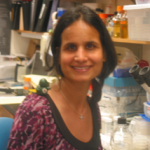 Neuronal control of stress response and innate immunity in C. elegans
Neuronal control of stress response and innate immunity in C. elegans
Heat Shock Protein (HSP) and Unfolded Protein Response (UPR) genes are upregulated in response to various stresses including heat shock, oxidative stress and ER stress. In C. elegans, HSP and UPR genes are also required for an adequate immune response to pathogens. Recent studies have shown that thermosensory neurons can regulate HSP gene induction at the organismal level. Increasing evidence also indicates that the nervous system of C. elegans controls avoidance to certain pathogens and activation of innate immune pathways. To identify neurons capable of controlling the activation of HSP or UPR genes as well as innate immune responses to pathogens, we screened mutants, in genes involved in the function of sensory neurons, for expression of stress proteins in response to bacterial pathogens and their pathogen susceptibility. Mutation in thermosensory neurons affected not only the expression of stress proteins but also pathogen susceptibility. Additional sensory neurons suppressed innate immunity while others enhanced innate immunity.
___________________________________________
| Name: | Alex Saka |
| Lab: | Valdivia |
| Conference: | Fifth Biennial Meeting of the Chlamydia Basic Research Society |
| Date: | March 18-21, 2011 |
| Location: | Redondo Beach, CA |
| Purpose: | To present talk and poster |
Abstract:
 Quantitative proteomics reveals metabolic and pathogenic properties of Chlamydia trachomatis developmental forms
Quantitative proteomics reveals metabolic and pathogenic properties of Chlamydia trachomatis developmental forms
Chlamydia trachomatis is an obligate intracellular pathogen responsible for ocular and genital infections of significant public health importance. C. trachomatisundergoes a biphasic developmental cycle alternating between two distinct forms: the infectious elementary body (EB), with a highly cross-linked outer membrane shell and a condensed nucleoid, and the reticulate body (RB), a larger, replicative but non-infectious form. The molecular basis for these developmental transitions and the metabolic properties of the EB and RB forms are poorly understood as these bacteria are not amenable to genetic analysis or in vitro physiological studies. Here we used two-dimensional liquid chromatography – tandem mass spectrometry (LC/LC-MS/MS) to perform a large-scale, label-free quantitative proteomic analysis of C. trachomatis LGV-L2 EBs purified at 44 and RBs at 18 hours post infection (hpi). Additionally, we carried out LC-MS/MS to analyze the membranes of the pathogen-containing vacuole (“inclusion”). We developed label-free quantification approaches to measure protein abundance in a mixed-proteome background and deployed for EB and RB quantitative analysis. In this manner, we catalogued the relative distribution of >54% of the predicted proteins in the C. trachomatis LGV-L2 proteome. Proteins required for central metabolism and glucose catabolism were predominant in EBs, while proteins associated with protein synthesis, ATP generation and nutrient transport were most abundant in RBs. These findings suggest that the EB is primed for a burst in metabolic activity upon entry, whereas the RB form is geared towards nutrient utilization, a rapid increase in cellular mass, and securing the resources for an impending transition back to the EB form. The most revealing difference between the two forms was the relative deficiency of Type III secretion (T3S) basal components in the RB stage at 18 hpi, suggesting a reduced T3S capacity or a low frequency of active T3S apparatus assembled on a “per organism” basis. Our results provide experimental evidence to support existing models of a “communal” chlamydial virulence, wherein RBs, unlike EBs, can invest a greater percentage of resources to bacterial replication by sharing the task of T3S assembly and effector proteins translocation with all members of the inclusion community.
_________________________________
| Name: | Lukasz Kozubowski |
| Lab: | Heitman |
| Conference: | Eighth International Conference onCryptococcus and Cryptococcosis |
| Date: | May 1-5, 2011 |
| Location: | Charleston, SC |
| Purpose: | To present two abstracts and poster |
Abstract:
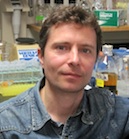 Association of Calcineurin with the COPI Protein Sec28 and the COPII Protein Sec13 Revealed by Quantitative Proteomics
Association of Calcineurin with the COPI Protein Sec28 and the COPII Protein Sec13 Revealed by Quantitative Proteomics
Calcineurin is a calcium-calmodulin-dependent serine/threonine specific protein phosphatase operating in key cellular circuits governing responses to extracellular cues. Calcineurin is essential for growth at high temperature and virulence of Cryptococcus neoformans but the underlying mechanisms are unknown. We performed mass spectrometry analysis to identify proteins that associate with the calcineurin A catalytic subunit (Cna1) inC. neoformans cells under non-stress and high temperature stress conditions. A novel prioritization strategy mass spectrometry data identified putative substrates and proteins potentially operating with calcineurin in common pathways. Cna1 co-purified with proteins involved in membrane trafficking, including the COPI component Sec28 and its regulator Arf1, the COPII component Sec13, and a dynamin-like GTPase Vps1. Cna1 exhibited a dramatic change in subcellular localization during high temperature stress from diffuse cytoplasmic to ER-associated puncta and the mother-bud neck and co-localized with Sec28 and Sec13. Inhibition of calcineurin activity conferred a cellular defect in vacuolar organization. These data suggest that during high temperature stress, Cna1 associates with COPI and COPII complexes on ER-derived membranes and contributes to membrane traffic.
Calcineurin co-localizes with P-bodies and stress granules and controls protein translation during thermal stress inCryptococcus neoformans
Calcineurin is a calcium-calmodulin-activated serine-threonine specific protein phosphatase that operates during cellular responses to stress. Calcineurin is essential for the virulence ofCryptococcus neoformans, but the mechanisms involved remain elusive. In particular, mechanisms of calcineurin-evoked stress responses that do not involve transcriptional changes are poorly characterized.
Our studies reveal a novel transcription-independent role of calcineurin during high temperature-stress response of C. neoformans and show for the first time the dynamic changes of calcineurin localization in response to stress. The diffusely cytoplasmic calcineurin catalytic subunit Cna1 relocates to ER-associated puncta and the mother-bud neck when cells are subjected to 37°C. Strikingly, more than 50% of Cna1 puncta contain the decapping enzyme Dcp1 and the poly (A)-binding protein Pub1, which are constituents of P-bodies and stress granules, respectively. In contrast to wild type cells, in calcineurin mutant cells exposed to heat stress, protein synthesis perdures inappropriately and this is accompanied by lower levels of phosphorylated eIF2 alpha. These results support a model in which calcineurin operates during thermal stress by associating with mRNA processing structures and governing translation of mRNAs.
_________________________________
| Name: | Sehoon Keum |
| Lab: | Marchuk |
| Conference: | Mouse Genetics 2011 |
| Date: | June 22-25, 2011 |
| Location: | Washington, DC |
| Purpose: | To present talk and poster |
Abstract:
 A genetic locus mapping to chromosome 4 unrelated to collateral circulation determines cerebral infarction in a mouse model of ischemic stroke
A genetic locus mapping to chromosome 4 unrelated to collateral circulation determines cerebral infarction in a mouse model of ischemic stroke
In a mouse model of ischemic stroke, infarct volume is highly variable and strain dependent, but the natural genetic determinants responsible for this difference remain unknown. After permanent distal middle cerebral artery occlusion (MCAO), infarct volume was determined for 16 inbred mouse strains. Subsequently, we and others have demonstrated that the extent of pial collateral circulation in the brain is inversely correlated with infarct volume data for the inbred mouse strains. We also mapped the identical chromosome 7 locus for infarct volume that was also mapped for pial collateral artery density in F2 (B6xBALB/c) intercrosses. Intriguingly, we have found that one strain of mouse, C3H/HeJ (C3H), does not follow the correlation. Both B6 and C3H strains exhibit a similarly large number of collateral vessels but the observed infarct volumes were significantly different between the strains. These two additional strains may provide evidence for the presence of additional loci controlling infarct volume, independent of collateral vessel number. To identify genetic determinants modulating infarct tissue damage, we performed quantitative trait locus (QTL) analysis of surgically-- induced cerebral infarct volume. We have identified a single locus mapping to chromosome 4 that modulates infarct volume, accounting for over 50% of the variation, with a LOD score of 5.3. Taken together, our new linkage data suggests that genetic variation underlying the chromosome 4 locus might be associated with a different physiological mechanism from collateral circulation. Therefore, identification of the genes underlying this new locus may uncover novel genetic and physiological pathways that modulate cerebral infarction and provide new targets for therapeutic intervention in ischemic stroke, and possibly other human vascular occlusive diseases.
_________________________________
2010 MGM Distinguished Fellows Travel Awards
| Name: | Joe Dan Dunn |
| Lab: | Valdivia |
| Conference: | American Society for Microbiology 2010 General Meeting |
| Date: | May 23 – 27, 2010 |
| Location: | San Diego, California |
| Purpose: | To present talk and poster |
Abstract:
 Functional genomics and proteomics identify effector proteins in Chlamydia trachomatis elementary bodies
Functional genomics and proteomics identify effector proteins in Chlamydia trachomatis elementary bodies
The sexually transmitted obligate intracellular Gram-negative pathogenChlamydia trachomatis translocates effector proteins into its host cell to facilitate entry and to establish an environment suitable for replication. Elementary bodies (EBs), the infectious form of Chlamydia, likely employ a large cohort of effectors that are critical for establishing an infection. The lack of both a system for genetic manipulation and a cell-free culture system suitable for biochemical approaches has hindered the identification of these effector proteins. Moreover, C. trachomatis is of a highly divergent lineage of ancient pathogens, and many of its genes have homologs only in other Chlamydia species. To overcome these difficulties, we used a combination of functional genomics and proteomic approaches to identify potential effectors that are translocated during EB attachment and entry. We created a mammalian expression library comprising ~130 Chlamydia-specific ORFs fused to EGFP, and monitored the subcellular localization of these fusion proteins in transiently transfected HeLa cells. A distinct subset of these fusion proteins displayed tropism for specific host organelles. Because effector proteins secreted during the initial stages of infection are likely pre-packaged into the metabolically inert EBs, we used two-dimensional liquid chromatography of trypsin-digested EB proteins followed by quantitative tandem mass spectroscopy to identify the most abundant Chlamydia-specific proteins in EBs. In addition to TARP, a previously characterized effector that nucleates actin, we identified over 25 new potential effectors. A significant subset of these abundant EB proteins are predicted to be substrates of type 3 secretion and/or target specific mammalian organelles, including the plasma membrane, the Golgi apparatus, the nuclear envelope, and the nucleolus, when expressed as EGFP fusions. These observations suggest that numerous host cell modifications occur during the earliest stages of Chlamydia infection.
_________________________________
| Name: | Min Ni |
| Lab: | Heitman |
| Conference: | 8th International Conference on Cryptococcusand Cyptococcosis (ICCC) |
| Date: | May 1-5, 2011 |
| Location: | Charleston, SC |
| Purpose: | To present talk and poster |
Abstract:
 Unisexual reproduction induces phenotypic and genotypic plasticity in Cryptococcus neoformans
Unisexual reproduction induces phenotypic and genotypic plasticity in Cryptococcus neoformans
Cryptococcus neoformans is a globally distributed human pathogen, which mostly infects patients with compromised immunity, such as AIDS patients, causing life-threatening meningitis. C. neoformans is a basidiomycetous fungus that typically grows as a haploid budding yeast. It has a bipolar mating system with two mating types: a and α. Although we have defined opposite-sex mating between a and α cells under laboratory conditions, more than 99% of natural isolates are α. Interestingly α cells can fuse only α and undergo same-sex mating to generate spores. Sex is costly, thus the question arises as why C. neoformans would undergo same-sex mating as opposed to asexual reproduction. We hypothesize that same sex mating is a hypermutagenic process that generates diverse progeny that can adapt to changing environments.
To test this hypothesis, I isolated progeny from same-sex mating by microdissecting spores and performed phenotypic and genotypic analysis. Compared to the parent strain, about 8% of progeny (7 out of 90) exhibit stable phenotypic changes including temperature sensitive growth, drug sensitivity, and enhanced production of melanin (a unique dark pigment generated by Cryptococcus as a virulence factor). Comparative genomic hybridization (CGH) analysis for these seven progeny revealed that four are aneuploid, in which an extra chromosome 9, 10, 10, or 13 is present. When the aneuploid progeny lose the extra chromosome, they lose their acquired phenotypes, suggesting that aneuploidy is responsible for the phenotypic changes. Pulsed field gel electrophoresis (PFGE) analysis revealed that translocations are found in three progeny (two of which are also aneuploid). SNPs and Indels were discovered in three progeny (two of which are aneuploid) by whole genome sequencing. These findings indicate that same-sex mating induces phenotypic and genotypic plasticity.
To test whether these genetic changes are unique to same-sex mating. I isolated progeny from asexual mitotic reproduction and opposite-sex mating between two congenic strains. I did not observe any phenotypic changes among mitotic progeny. Although phenotypic variants (~9%) were observed in progeny resulting from opposite-sex mating, no aneuploidy was detected, suggesting that a high rate of aneuploidy may be a unique feature of same-sex mating. To validate this hypothesis, a multiplex PCR-based method was developed to detect the rate of aneuploidy in all three processes: same-sex mating, opposite-sex mating and asexual mitotic reproduction. These experiments are currently in progress.
Same-sex mating was recently discovered to occur in another human pathogen, Candida albicans. The ability to undergo same-sex mating may be an evolutionary advantage for human pathogens: it generates genotypic and phenotypic plasticity, as we have shown. Furthermore, a high rate of aneuploidy is generated during same sex mating. Aneuploidy is deleterious in humans, causes severe diseases, such as Down syndrome and occurs commonly in cancers. However, in microorganism, aneuploidy can be advantageous. Several studies have shown that aneuploidy enables certain fungal pathogens to overcome adverse conditions such as antifungal drug exposure and adapt rapidly to new environments. Our study suggests that aneuploidy may serve as a mechanism to generate genetic diversity and rapid adapt to stressful environments.
___________________________________
| Name: | Sarah Linnstaedt |
| Lab: | Cullen |
| Conference: | 14th Biennial Conference of the International Association for Research on Epstein-Barr Virus and Associated Diseases |
| Date: | September 4 – 10, 2010 |
| Location: | Edgbaston, Birmingham |
| Purpose: | To present talk and poster |
Abstract:
 Virally induced cellular miR-155 plays a key role in B cell immortilization by EBV
Virally induced cellular miR-155 plays a key role in B cell immortilization by EBV
EBV infection of primary B cells in culture causes transformation into indefinitely dividing lymphoproliferative cell lines (LCLs). This process serves as a model system of lymphomagenesis, especially for diffuse large B-cell lymphoma (DLBCL) and AIDS associated lymphomas. Upon infection, EBV up-regulates a number of cellular microRNAs, with the biggest effect seen on miR-155. As early as 70 hours after infection, miR-155 levels were increased over 10 times compared to resting B cells and, in established LCLs, miR-155 makes up approximately half of the total miRNA population. The extent of up-regulation of miR-155 by EBV and its high level of expression in LCLs suggest a role for miR-155 in the transformation of primary B cells by EBV as well as the maintenance of LCLs, especially given previous data demonstrating that miR-155 over-expression is etiologically linked to B cell transformation. We used a miR-155-specific sponge to achieve the functional knock down of miR-155 in LCLs. In competitive growth assays, miR-155 deficient LCLs were strongly impaired for growth compared to control-transduced cells. The failure of miR-155 deficient LCLs to compete is due, at least in part, to increased apoptosis as well as their arrest in the G1 phase of the cell cycle. We are currently testing the consequences of miR-155 over-expression on the efficiency of transformation by EBV and performing experiments to better characterize the observed phenotype and elucidate the underlying mechanisms.
___________________________________
| Name: | Hao Tang |
| Lab: | Marchuk |
| Conference: | American Heart Association’s Basic Cardiovascular Sciences Scientific Session |
| Date: | July 19 – 21, 2010 |
| Location: | Rancho Mirage, California |
| Purpose: | To present talk and poster |
Abstract:
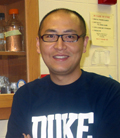 The kinase activity of TNNI3K, a modifier of murine heart failure
The kinase activity of TNNI3K, a modifier of murine heart failure
Heart failure is the common final outcome of many forms of acute and chronic heart disease. The prognosis of heart disease is highly variable between patients, and these differences in the phenotypic expression (symptoms, course, and final outcome) are in part due to genetic factors that have proven difficult to directly identify in the human population. Using a disease-sensitized mouse model of dilated cardiomyopathy, and crosses between different inbred strains of mice, we have identified 7 heart failure modifier (Hrtfm) loci that modify the progression and outcome of the phenotype. We recently identified the gene underlying one of these modifier loci, Hrtfm2, ascardiac Troponin I-interacting kinase (Tnni3k). We showed that the expression of this gene accelerates disease progression in two distinct mouse models of cardiomyopathy, indicating its critical role in the regulation of cardiac function (Wheeler, Tang et al., 2009). However, the biochemical properties and function of TNNI3K under both normal and pathological conditions are unknown. Using wild type and “kinase-dead” (TNKD) mutant genes, we have now demonstrated that TNNI3K possess dual kinase function in vitro and in vivo. We have also now shown that TNKD transgenic mice do not modify disease progression in transverse aortic constriction induced (left ventricular pressure overload) cardiomyopathy, suggesting that TNNI3K kinase activity is essential for its disease modifier function. We have also shown that TNNI3K co-localizes with Desmin in mouse cardiomyocytes, and TNNI3K co-immunoprecipitates with two Z disc components, alpha actin and myotilin. These combined data suggest that TNNI3K is a sarcomeric Z disc kinase that mediates cytoplasmic signals to sarcomeric structural proteins to modulate cardiac contractility. Furthermore, we have identified a tyrosine kinase inhibitor that inhibits TNNI3K kinase activity both in vitro and in vivo. This finding provides a new tool for the study of TNNI3K function and provides a potential opportunity for pharmacologic intervention in heart disease.
___________________________________
| Name: | Eleonora Forte |
| Lab: | Luftig |
| Conference: | 12th International Conference on Malignancies in AIDS and Other Acquired Immunodeficiencies (ICMAOI) |
| Date: | April 26 – 27 , 2010 |
| Location: | Bethesda, Maryland |
| Purpose: | To present talk and poster |
Abstract:
 EBV-Induced miR-34a Functions To Stimulate Transformed B Cell Growth
EBV-Induced miR-34a Functions To Stimulate Transformed B Cell Growth
Background. Epstein-Barr virus (EBV) is a member of the γ-herpesvirus family estimated to infect 90% of the world’s population. Despite the high prevalence of infection, EBV-associated malignancies are largely kept in check by a strong cytotoxic T cell immune response. However, EBV causes lymphoproliferative disease in immune-deficient individuals and plays a role in the pathogenesis of African Burkitt lymphoma, Hodgkin’s disease, and nasopharyngeal carcinoma. In vitro, EBV infection of B cells results in proliferation and outgrowth of indefinitely proliferating lymphoblastoid cell lines (LCLs). Thus, LCLs represent a viable model for the pathogenesis of EBV-associated malignancies.
microRNAs are small non coding RNAs that post-transcriptionally regulate gene expression to control a variety of processes including development, cell cycle, and immunity. Their role in EBV transformation and lymphomas is currently not well understood.
Results. Using a miRNA microarray, we identified a number of cellular miRNAs that were over- or under-expressed comparing resting CD19+ B cells to EBV-infected, proliferating B cells and immortalized LCLs. In particular, we focused on miR-34a, whose expression was induced by EBV. This miRNA has been previously reported to be a pro-apoptotic target of p53 implicated in the response to DNA damage. Surprisingly, contrary to its regulation in other cell types, miR-34a was not found to be p53 responsive in LCLs. In order to understand the functional role of this miRNA in EBV transformation we constructed a miRNA sponge. miR-34a knock down in LCLs showed that these cells depend on normal miR-34a expression to proliferate and to aggregate.
Conclusions. miR-34a is important for efficient growth and survival of EBV-transformed cells, in contrast to its tumor suppressive role in carcinoma and sarcoma-derived cell lines.